Home » Posts tagged 'IncrediblePBX' (Page 28)
Tag Archives: IncrediblePBX
Almost Free: Professional Grade TTS Comes to Issabel 4

There’s no need to be chained to your TV for breaking news and weather forecasts when they can be as close as the nearest VoIP phone. Today we’re elevating text to speech with Issabel to commercial-quality. We’re wrapping up our month-long romance with Issabel 4 by introducing IBM’s Bluemix TTS service for Incredible PBX®. It’s surprisingly affordable. The first million characters of text-to-speech synthesis are FREE every month so, for most users, upgrading to commercial quality speech synthesis is a no-brainer. Try out our 10-second demo and prepare to be amazed. We provided a plain text demo (without any voice transformation SSML) to show how incredibly accurate IBM’s basic voice synthesis engine is. With additional tweaking using IBM’s SSML functions, any voice nuances can be quickly corrected or enhanced. Feel free to build a few samples on your own at IBM’s demo site.
[soundcloud url="https://api.soundcloud.com/tracks/335398310″ params="auto_play=false&hide_related=false&show_comments=true&show_user=true&show_reposts=false&visual=true" width="80%" height="414″ iframe="true" /]
An awesome text-to-speech engine, of course, is only half of the story. You still need application software to bring TTS to life on your PBX. Nerd Vittles tried and true news and weather applications for Incredible PBX provide the glue that binds news and weather updates to your phone by simply dialing a 3-digit extension on your PBX. 951 gets you the latest breaking news from Yahoo, and 947 gets you current weather conditions and a weather forecast for any zip code in the United States. It’s pure, open source GPL code so feel free to modify it to meet your needs. Additional weather data is available from IBM Bluemix at modest cost for our international friends. Make that your weekend project!
Getting Started with IBM Bluemix TTS Service
NOV. 1 UPDATE: IBM has moved the goal posts effective December 1, 2018:

You can start your free, 30-day trial of IBM Bluemix services without providing a credit card. Just sign up here. Once your account is activated, here’s how to obtain credentials for the TTS service to use with Incredible PBX for Issabel. Start by logging in to your IBM Bluemix account. Once you’re logged in, click on your account name (1) in the upper right corner of your web page to reveal the pull-down to select your Region, Organization, and Space. Follow the blue links at the bottom of the pull-down menu to create an Organization and Space for your TTS service.
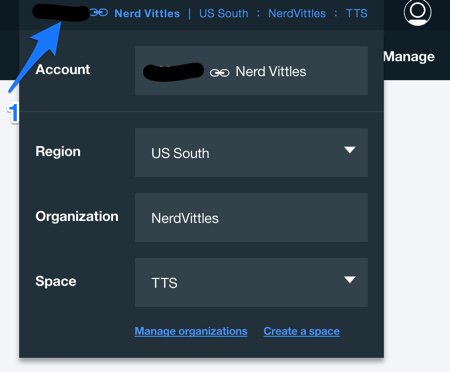
Next, click the Menu icon which is displayed as three horizontal bars on the left side of the web page. Choose Watson. Click Create Watson Service and select Text to Speech from the applications listing. Watson will generate a new TTS service template and display it. Make certain that your Region, Organization, and Space are shown correctly. Then verify that the Standard Pricing Plan is selected. When everything is correct, click the Create button.
When your Text to Speech application displays, click Service Credentials and then click New Credential (+). When the Add New Credential dialog appears, leave the default settings as they are and click Add. Your Credentials Listing then will appear. Click View Credentials beside the new entry you just created. Write down your URL, username, and password. You’ll need these to configure the IBM Bluemix TTS service in Issabel momentarily. Logout of the IBM Cloud by clicking on the little face in the upper right corner of your browser window and choose Log Out. Confirm that you do, indeed, wish to log out. NOTE: For new implementations, you will have an APIkey instead of a username and password.
Implementing IBM Bluemix TTS Service with Issabel
Now for the fun part. We’ve built all the pieces you’ll need to deploy IBM’s TTS service and to reconfigure the Incredible PBX news and weather applications to take advantage of IBM’s new text synthesis engine. There are 5 Simple Steps to put all the pieces in place for this. Begin by (1) installing Issabel 4 on your favorite platform. Next, (2) install Incredible PBX for Issabel by following our tutorial. Now (3) log into your Issabel PBX as root using SSH or Putty and issue the following commands:
cd /var/lib/asterisk/agi-bin wget http://incrediblepbx.com/ibmtts-issabel.tar.gz tar zxvf ibmtts-issabel.tar.gz nano -w /var/lib/asterisk/agi-bin/ibmtts.php
When the installation finishes, (4) an editor will open to let you insert your IBM Bluemix TTS credentials. Do so and then press Ctrl-X, Y, and Enter to save your entries. For new deployments, your API Username will be apikey, and your API Password will be your actual APIkey. Finally, while still in the agi-bin directory, (5) run the following script to update your Asterisk dialplan: ./install-ibmtts-dialplan.sh.
Now you’re ready to take IBM’s Bluemix TTS for a test drive. Pick up any phone connected to your PBX and dial 951 for the latest Yahoo news. Then dial 947 and enter a 5-digit zip code to retrieve the latest weather conditions and weather forecast for your zip code. Enjoy!
If you’d like to try out the News application with IBM Bluemix, feel free call our Demo PBX and choose option 5: 
Published: Monday, July 31, 2017
 Support Issues. With any application as sophisticated as this one, you’re bound to have questions. Blog comments are a difficult place to address support issues although we welcome general comments about our articles and software. If you have particular support issues, we encourage you to get actively involved in the PBX in a Flash Forum. It’s the best Asterisk tech support site in the business, and it’s all free! Please have a look and post your support questions there. Unlike some forums, the PIAF Forum is extremely friendly and is supported by literally hundreds of Asterisk gurus and thousands of users just like you. You won’t have to wait long for an answer to your question.
Support Issues. With any application as sophisticated as this one, you’re bound to have questions. Blog comments are a difficult place to address support issues although we welcome general comments about our articles and software. If you have particular support issues, we encourage you to get actively involved in the PBX in a Flash Forum. It’s the best Asterisk tech support site in the business, and it’s all free! Please have a look and post your support questions there. Unlike some forums, the PIAF Forum is extremely friendly and is supported by literally hundreds of Asterisk gurus and thousands of users just like you. You won’t have to wait long for an answer to your question.

Need help with Asterisk? Visit the PBX in a Flash Forum.
Special Thanks to Our Generous Sponsors
FULL DISCLOSURE: ClearlyIP, Skyetel, Vitelity, DigitalOcean, Vultr, VoIP.ms, 3CX, Sangoma, TelecomsXchange and VitalPBX have provided financial support to Nerd Vittles and our open source projects through advertising, referral revenue, and/or merchandise. As an Amazon Associate and Best Buy Affiliate, we also earn from qualifying purchases. We’ve chosen these providers not the other way around. Our decisions are based upon their corporate reputation and the quality of their offerings and pricing. Our recommendations regarding technology are reached without regard to financial compensation except in situations in which comparable products at comparable pricing are available from multiple sources. In this limited case, we support our sponsors because our sponsors support us.
 BOGO Bonaza: Enjoy state-of-the-art VoIP service with a $10 credit and half-price SIP service on up to $500 of Skyetel trunking with free number porting when you fund your Skyetel account. No limits on number of simultaneous calls. Quadruple data center redundancy. $25 monthly minimum spend required. Tutorial and sign up details are here.
BOGO Bonaza: Enjoy state-of-the-art VoIP service with a $10 credit and half-price SIP service on up to $500 of Skyetel trunking with free number porting when you fund your Skyetel account. No limits on number of simultaneous calls. Quadruple data center redundancy. $25 monthly minimum spend required. Tutorial and sign up details are here.
 The lynchpin of Incredible PBX 2020 and beyond is ClearlyIP components which bring management of FreePBX modules and SIP phone integration to a level never before available with any other Asterisk distribution. And now you can configure and reconfigure your new Incredible PBX phones from the convenience of the Incredible PBX GUI.
The lynchpin of Incredible PBX 2020 and beyond is ClearlyIP components which bring management of FreePBX modules and SIP phone integration to a level never before available with any other Asterisk distribution. And now you can configure and reconfigure your new Incredible PBX phones from the convenience of the Incredible PBX GUI.
 VitalPBX is perhaps the fastest-growing PBX offering based upon Asterisk with an installed presence in more than 100 countries worldwide. VitalPBX has generously provided a customized White Label version of Incredible PBX tailored for use with all Incredible PBX and VitalPBX custom applications. Follow this link for a free test drive!
VitalPBX is perhaps the fastest-growing PBX offering based upon Asterisk with an installed presence in more than 100 countries worldwide. VitalPBX has generously provided a customized White Label version of Incredible PBX tailored for use with all Incredible PBX and VitalPBX custom applications. Follow this link for a free test drive!
 Special Thanks to Vitelity. Vitelity is now Voyant Communications and has halted new registrations for the time being. Our special thanks to Vitelity for their unwavering financial support over many years and to the many Nerd Vittles readers who continue to enjoy the benefits of their service offerings. We will keep everyone posted on further developments.
Special Thanks to Vitelity. Vitelity is now Voyant Communications and has halted new registrations for the time being. Our special thanks to Vitelity for their unwavering financial support over many years and to the many Nerd Vittles readers who continue to enjoy the benefits of their service offerings. We will keep everyone posted on further developments.
Some Recent Nerd Vittles Articles of Interest…
The Perfect Pair: Flawless VoIP with Issabel 4 and 3CX

We continue our Issabel 4 adventure today with a VoIP match made in heaven. Today, we’ll take advantage of the Nerd Vittles free 3CX server offering and interconnect it with an Issabel 4 PBX to enjoy the best of both worlds. From Issabel extensions, you can call your 3CX Clients by dialing 4 digits. From 3CX Clients, you can call Issabel extensions as well as your Asterisk® applications in the same way with the added bonus of being able to make outbound calls through your Issabel trunks by dialing any number with a 9 prefix. Once you have both of your PBXs running, the setup time to interconnect them is under 5 minutes.
Why would you want to maintain two PBXs? The simple answer is the added flexibility you achieve coupled with a 99% reduction in VoIP headaches. If you haven’t yet used 3CX Clients on a PC or Mac desktop or on an iOS or Android device, you have missed perhaps the greatest VoIP advancement of the last decade. As the name suggests 3CX Clients connect to a 3CX server with less than a one-minute setup. They work flawlessly from anywhere using WiFi or cellular. As an added bonus, you can kiss all of your Asterisk NAT woes goodbye! If you ever travel or if you need remote phone access to your PBX infrastructure, you owe it to yourself to try a 3CX Client. We promise. You’ll never again use a traditional SIP client.
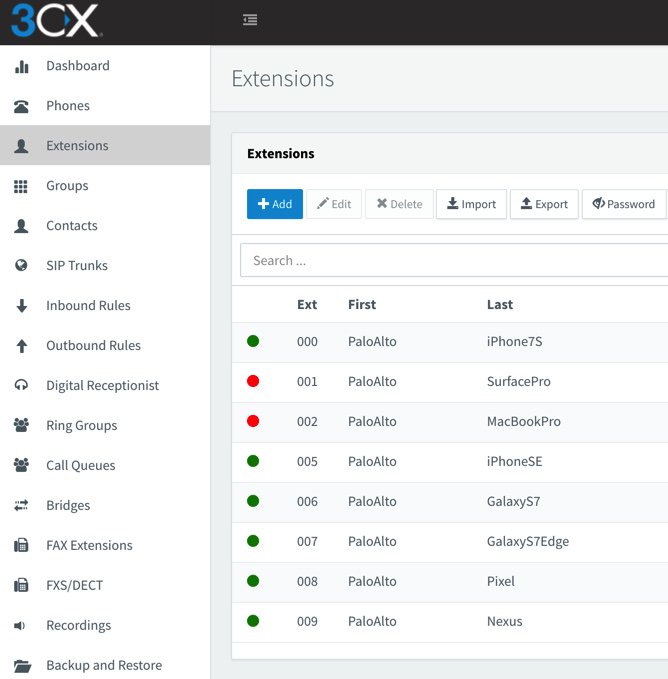
Building Your Issabel and 3CX Server Platforms
The prerequisite for interconnecting Issabel and 3CX servers is, of course, to install the two PBXs on platforms of your choice. Our preference is cloud-based servers because it avoids many of the stumbling blocks with NAT-based routers. If you know what you’re doing, you obviously can deploy the PBXs in any way you like. For the Issabel 4 PBX, start with our introductory tutorial to install Issabel 4. Then follow the Incredible PBX for Issabel tutorial to add security and the Asterisk bells and whistles. For 3CX, start with our introductory tutorial which includes a link to obtain a free perpetual license supporting 4 simultaneous calls and unlimited trunks. Then secure your server by adding the Travelin’ Man 3 firewall for 3CX. Once both servers are up and running, whitelist the IP address or FQDN of the Issabel PBX on the 3CX server and vice versa. You’ll find the add-ip and add-fqdn utilities in /root of each server.
Overview of Interconnection Methodology
If you’re new to all of this, suffice it to say that 3CX is a powerful, commercial PBX while Issabel relies upon Asterisk and FreePBX® for its basic telephony operation. The two systems are quite different in terms of their approaches to interconnectivity. While you can transparently interconnect one 3CX server to another one, you cannot accomplish the same thing when the second PBX is Asterisk-based. Instead, the Issabel PBX is configured as a SIP trunk on the 3CX platform. The limitation this causes is that extensions on the Issabel PBX can only direct dial extensions on the 3CX platform. Issabel-based extensions cannot utilize 3CX trunks to place outbound calls. There’s more flexibility on the 3CX side of things. 3CX extensions can place direct calls to Issabel extensions. They also can take advantage of Issabel-based trunks to place outbound calls. Additionally, as we noted above, 3CX extensions can take advantage of every Asterisk application hosted on the Issabel platform including all of the Incredible PBX® enhancements. This actually works out perfectly because you can deploy 3CX Clients for your end-users, and they can take advantage of all the extension and trunk resources on both the 3CX and Issabel platforms. It also greatly simplifies remote deployment by removing NAT one-way audio hassles while allowing almost instantaneous setup of remote 3CX Clients, even by end-users.
For our setup today, we’re assuming you have elected to use 3-digit extensions on both the Issabel and 3CX platforms. To call extensions connected directly to the alternate server, we will simply dial 9 + the extension number on the remote PBX. To make external calls from 3CX extensions using Issabel trunks, we will dial 9 + a 10-digit number. For international users, you can adjust the dialplan on both PBXs accordingly.
By default, SIP trunks are associated with a DID on the 3CX platform. We will register the 3CX DID trunk with Issabel to maintain connectivity; however, we will not register the corresponding trunk on the Issabel side with the 3CX server. Keep in mind that you can only route a 3CX DID to a single destination, i.e. an extension, a ring group, or an IVR. But we can use 3CX’s CallerID routing feature to send calls to specific 3CX extensions from Issabel extensions even using a single 3CX trunk. For each 3CX extension, we’ll create an Outbound Route on the Issabel side with a CallerID number that matches the 3CX extension number we wish to reach. On the 3CX side, we’ll create an Inbound CID Rule that specifies the extension number to which each matching CallerID number should be routed. This sounds harder than it actually is. So keep reading, and it’ll all make sense momentarily. Once you’ve set all of this up, we think you’ll agree that it makes sense to create the bulk of your extensions exclusively on the 3CX side.
Configuring Issabel PBX for Interconnection to 3CX
Let’s begin by creating a Trunk on the Issabel PBX to connect to your 3CX server. In the Issabel GUI, choose PBX:PBX Config:Trunks and Add a SIP Trunk. Fill in the blanks as shown below. Make up a very secure secret for your Trunk and be sure to leave the Outbound CallerID field blank. Click on the image below if you need to enlarge it.
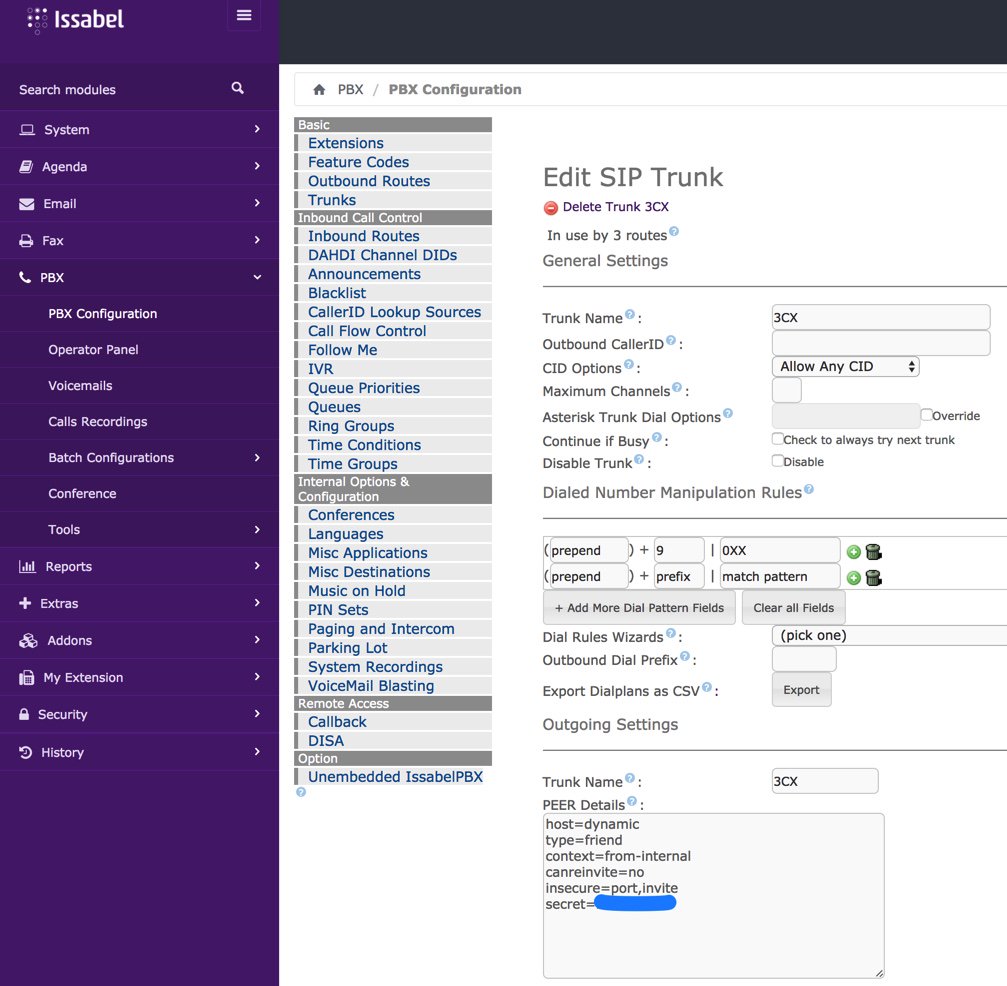
Because we set up the 3CX trunk with a from-internal destination context, we don’t need an Incoming Route for the 3CX Trunk. The calls will be processed exactly as if they were dialed from a local extension on the Issabel PBX, i.e. local calls will be routed to extensions and outgoing calls through trunks will be routed using your existing Outbound Routes.
Finally, we need to create the Outbound Routes for calls originating from Issabel extensions that should be directed to specific extensions on the 3CX platform. You’ll need a list of the 3CX extension numbers you wish to enable on the Issabel platform, and we’ll need to create a separate Outbound Route for each 3CX extension to be enabled. Create the Outbound Routes using the template below. We recommend including the 3CX extension in the Route Name. The Route CID and Route Pattern should be a 9 followed by the 3CX extension number for each Outbound Route you create. In the template below, we’re telling Issabel to route a call dialed as 9003 to extension 003 on the 3CX PBX. The Dial Manipulation Rule in the 3CX Trunk settings tells Issabel to strip off the 9 before sending the call to the 3CX PBX.
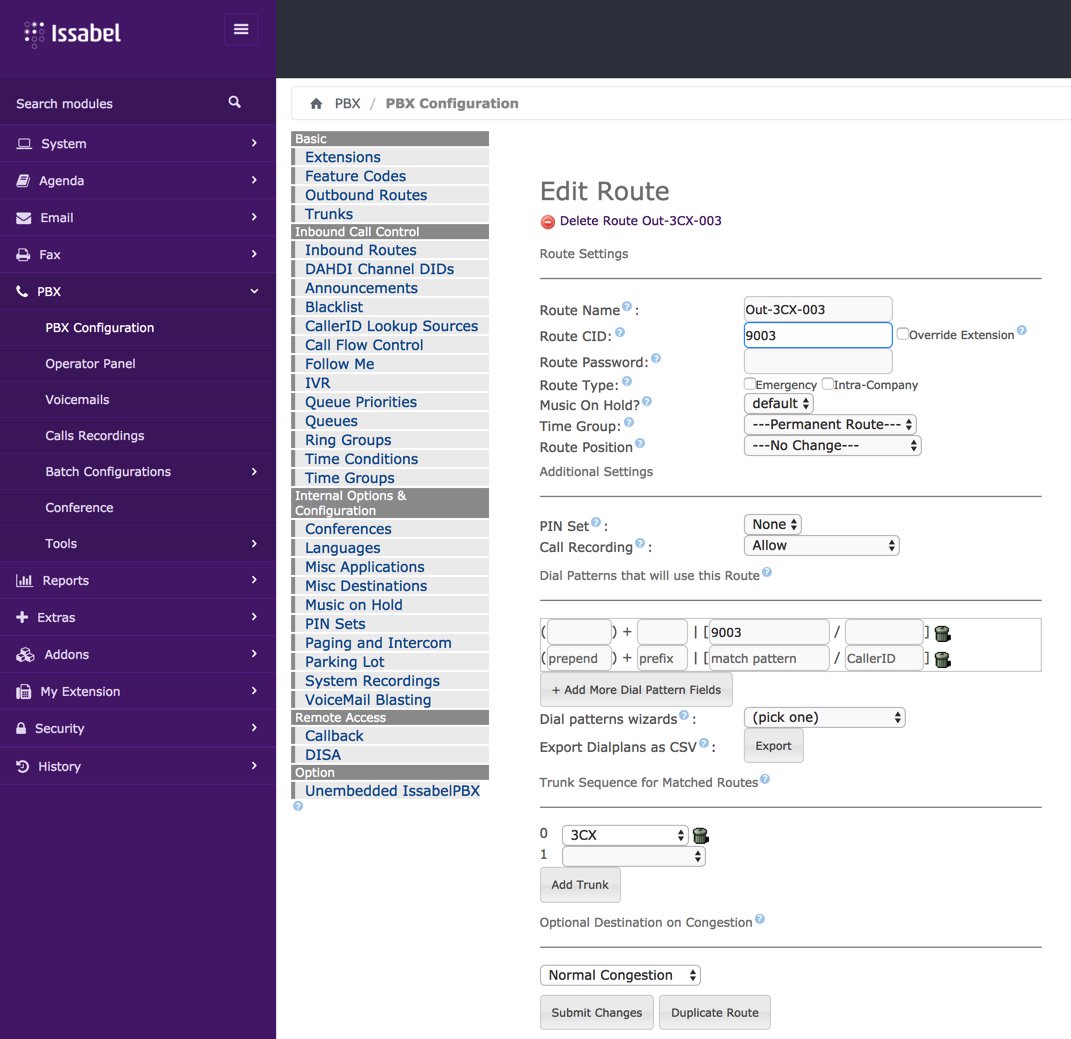
Configuring 3CX for Interconnection to Issabel PBX
Now we’re ready to set up the 3CX side to interconnect with your Issabel PBX. Start by creating a SIP Trunk and fill out the template as shown below using one of the phone numbers associated with your Issabel PBX as the Main Trunk No.
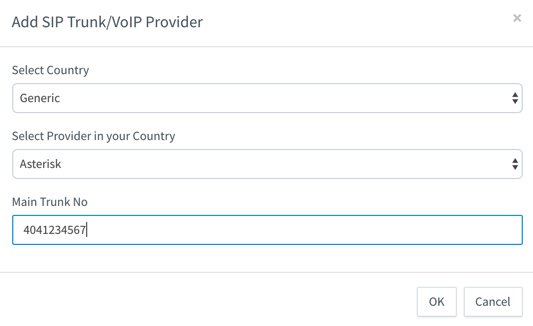
Fill in the Trunk Details using the example below. Be sure to specify the actual IP address or FQDN of your Issabel server as well as the SIP credentials of 3CX for username and the actual password you set up on the Issabel side of things. The Main Trunk No will be the same as you entered in the previous step. Choose a Default Destination for the Trunk.
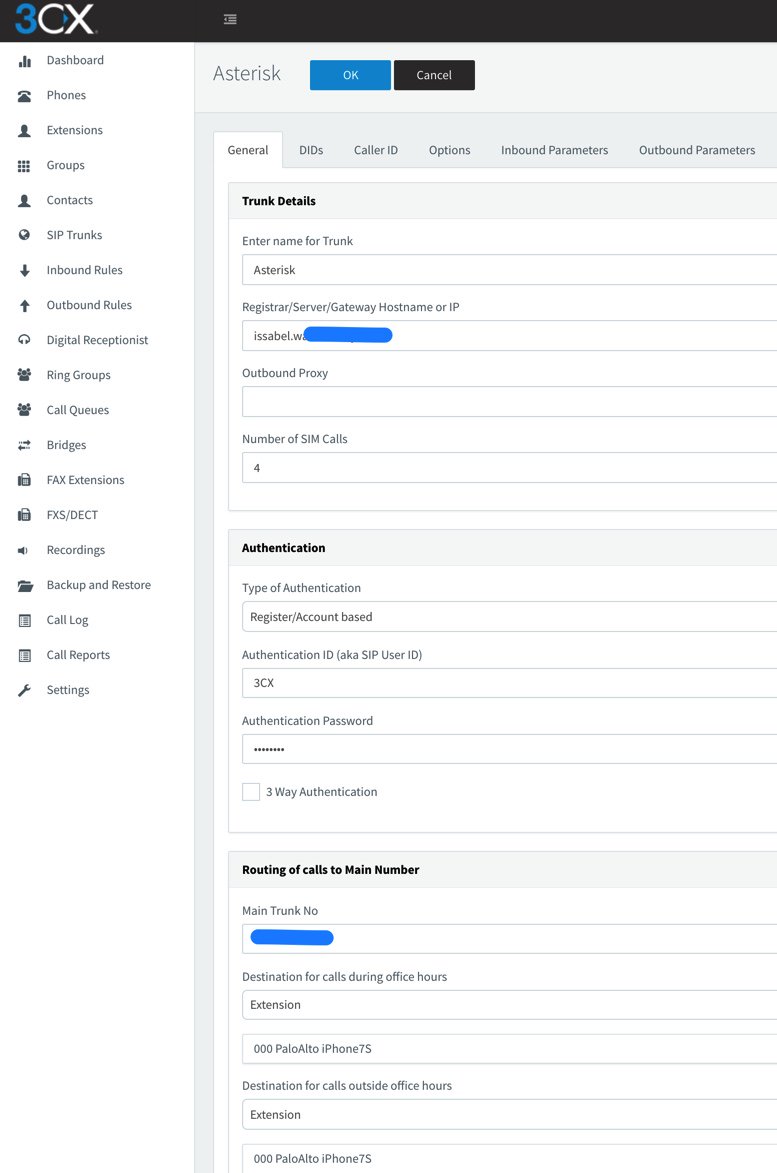
When the SIP Trunks listing redisplays, highlight your new Asterisk trunk and click Refresh Registration. The icon beside the Trunk should turn green. If not, be sure your IP address and password match the settings on the Issabel side. Don’t proceed until you get a green light!
Now we need two Outbound Routes for calls placed from 3CX extensions. One will handle calls destined for Local Extensions on the Issabel side. Our design is to place calls to Issabel extensions by dialing 9 + the 3-digit extension number. Adjust this to meet your own requirements. Be sure to set the Route as Asterisk with a value of 1 for Strip Digits.
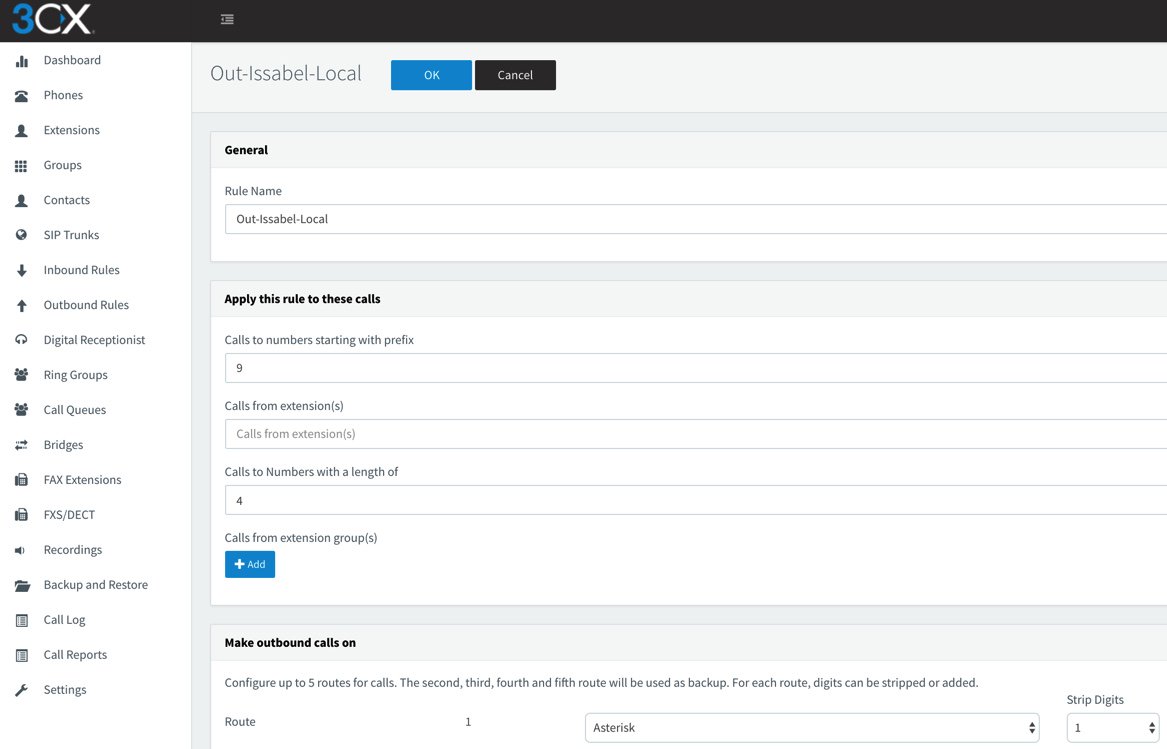
The other Outbound Route will handle calls destined for external calling with an Issabel trunk using a similar methodology. 3CX users will dial 9 + 10-digit number for calls to be processed by Trunks on the Issabel server.
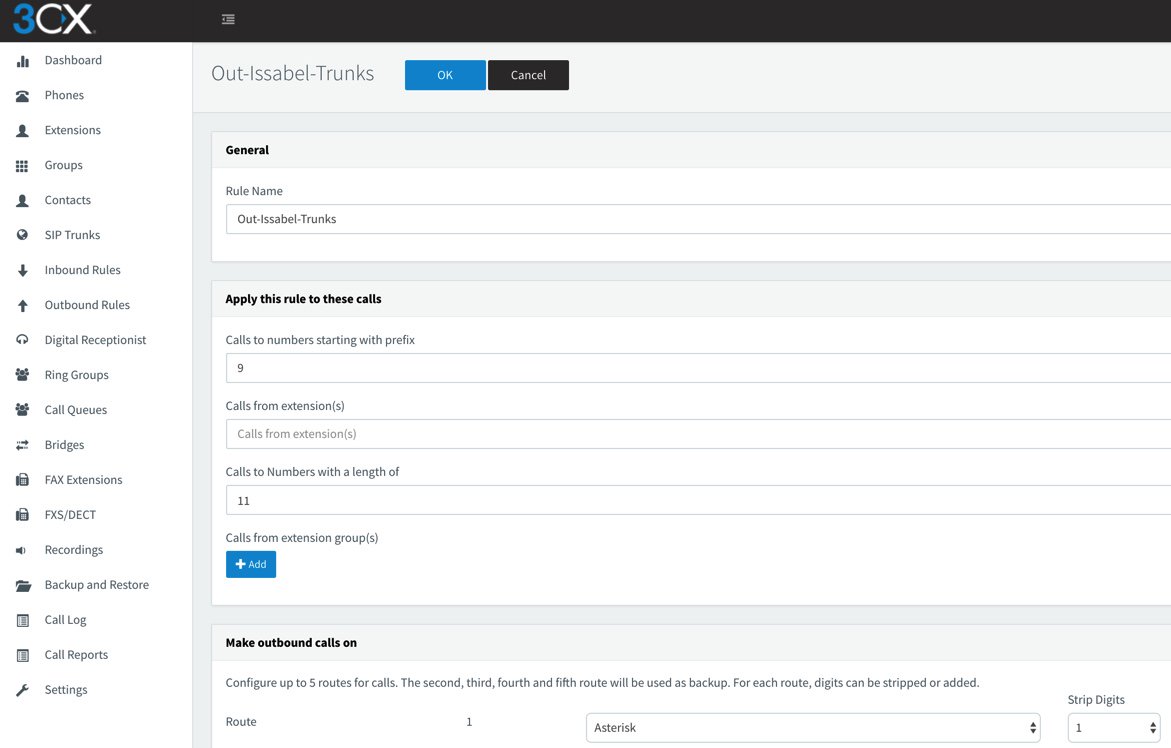
Finally, we need an Inbound Rule for every 3CX extension that you wish to enable for remote calling from Issabel extensions. Use the Add CID Rule option to create each Inbound Rule using the sample below. In our example, we’re authorizing incoming calls to 3CX extension 003 where the CallerID number of the incoming call is 003.
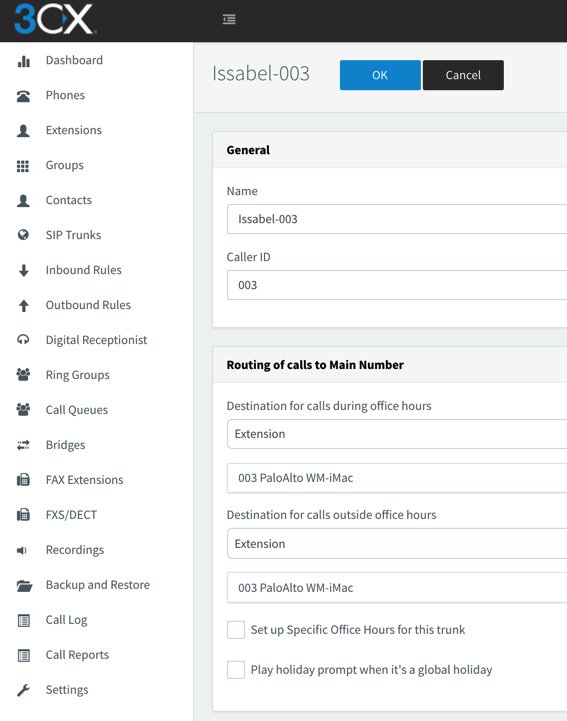
Test Drive Your Interconnected Servers
Now we’re ready to try things out. From an extension on the 3CX server, dial 9 plus any 3-digit extension that exists on the Issabel server. Next, dial 9 plus a 10-digit number such as your smartphone. The call should be routed out of your Issabel server using the Trunk associated with the NXXNXXXXXX rule in your Issabel Outbound Routes. Finally, from an extension on your Issabel PBX, dial 9 plus 000 which should route the call to extension 000 on your 3CX server. Enjoy!
Published: Wednesday, July 19, 2017
 Support Issues. With any application as sophisticated as this one, you’re bound to have questions. Blog comments are a difficult place to address support issues although we welcome general comments about our articles and software. If you have particular support issues, we encourage you to get actively involved in the PBX in a Flash Forum. It’s the best Asterisk tech support site in the business, and it’s all free! Please have a look and post your support questions there. Unlike some forums, the PIAF Forum is extremely friendly and is supported by literally hundreds of Asterisk gurus and thousands of users just like you. You won’t have to wait long for an answer to your question.
Support Issues. With any application as sophisticated as this one, you’re bound to have questions. Blog comments are a difficult place to address support issues although we welcome general comments about our articles and software. If you have particular support issues, we encourage you to get actively involved in the PBX in a Flash Forum. It’s the best Asterisk tech support site in the business, and it’s all free! Please have a look and post your support questions there. Unlike some forums, the PIAF Forum is extremely friendly and is supported by literally hundreds of Asterisk gurus and thousands of users just like you. You won’t have to wait long for an answer to your question.

Need help with Asterisk? Visit the PBX in a Flash Forum.
Special Thanks to Our Generous Sponsors
FULL DISCLOSURE: ClearlyIP, Skyetel, Vitelity, DigitalOcean, Vultr, VoIP.ms, 3CX, Sangoma, TelecomsXchange and VitalPBX have provided financial support to Nerd Vittles and our open source projects through advertising, referral revenue, and/or merchandise. As an Amazon Associate and Best Buy Affiliate, we also earn from qualifying purchases. We’ve chosen these providers not the other way around. Our decisions are based upon their corporate reputation and the quality of their offerings and pricing. Our recommendations regarding technology are reached without regard to financial compensation except in situations in which comparable products at comparable pricing are available from multiple sources. In this limited case, we support our sponsors because our sponsors support us.
 BOGO Bonaza: Enjoy state-of-the-art VoIP service with a $10 credit and half-price SIP service on up to $500 of Skyetel trunking with free number porting when you fund your Skyetel account. No limits on number of simultaneous calls. Quadruple data center redundancy. $25 monthly minimum spend required. Tutorial and sign up details are here.
BOGO Bonaza: Enjoy state-of-the-art VoIP service with a $10 credit and half-price SIP service on up to $500 of Skyetel trunking with free number porting when you fund your Skyetel account. No limits on number of simultaneous calls. Quadruple data center redundancy. $25 monthly minimum spend required. Tutorial and sign up details are here.
 The lynchpin of Incredible PBX 2020 and beyond is ClearlyIP components which bring management of FreePBX modules and SIP phone integration to a level never before available with any other Asterisk distribution. And now you can configure and reconfigure your new Incredible PBX phones from the convenience of the Incredible PBX GUI.
The lynchpin of Incredible PBX 2020 and beyond is ClearlyIP components which bring management of FreePBX modules and SIP phone integration to a level never before available with any other Asterisk distribution. And now you can configure and reconfigure your new Incredible PBX phones from the convenience of the Incredible PBX GUI.
 VitalPBX is perhaps the fastest-growing PBX offering based upon Asterisk with an installed presence in more than 100 countries worldwide. VitalPBX has generously provided a customized White Label version of Incredible PBX tailored for use with all Incredible PBX and VitalPBX custom applications. Follow this link for a free test drive!
VitalPBX is perhaps the fastest-growing PBX offering based upon Asterisk with an installed presence in more than 100 countries worldwide. VitalPBX has generously provided a customized White Label version of Incredible PBX tailored for use with all Incredible PBX and VitalPBX custom applications. Follow this link for a free test drive!
 Special Thanks to Vitelity. Vitelity is now Voyant Communications and has halted new registrations for the time being. Our special thanks to Vitelity for their unwavering financial support over many years and to the many Nerd Vittles readers who continue to enjoy the benefits of their service offerings. We will keep everyone posted on further developments.
Special Thanks to Vitelity. Vitelity is now Voyant Communications and has halted new registrations for the time being. Our special thanks to Vitelity for their unwavering financial support over many years and to the many Nerd Vittles readers who continue to enjoy the benefits of their service offerings. We will keep everyone posted on further developments.
Some Recent Nerd Vittles Articles of Interest…
Leap Into Summer: Introducing Incredible PBX for Issabel

NEWS FLASH: A new release of Incredible PBX for Issabel is now available. Tutorial is here.
If you didn’t already know, we’ve always liked free. No strings, no gotchas, no demoware, and no legal shenanigans. That’s why our introduction of Issabel 4 last week was such a breath of fresh air. While there’s now an awesome free version of 3CX, the open source community has had a very long dry spell. So today we celebrate a decade of adding fun to phone systems with the introduction of Incredible PBX® for Issabel 4. It includes our next generation, preconfigured Travelin’ Man 3 firewall, additional text-to-speech engines (FLITE, GoogleTTS, and PicoTTS), voice recognition, turnkey trunk and extension setups with preconfigured tollfree calling, Google Voice support with OAuth 2 or plain text passwords for free calling in the U.S. and Canada, SMS messaging, telephone reminders, turnkey fax support, AsteriDex phone book with both voice and speed dialing, Wolfram Alpha, sample ODBC apps, and a boatload of dialplan code and AGI scripts to help anyone wanting to learn how to develop custom applications with Asterisk®.
Installing Incredible PBX for Issabel 4
Let’s start with the basics and get all of the Incredible PBX components loaded. As with all Incredible PBX builds, running the Incredible PBX installer will erase ALL of your existing Issabel configuration. So begin with a clean, unaltered Issabel 4 platform with no added components or configuration changes. Be sure to use either the June or July ISO for base Issabel install. We will update it from there as part of the Incredible PBX install. Just follow last week’s tutorial to bring up Issabel 4 on a dedicated server or a virtual machine.
JUST RELEASED: A new tutorial to walk you through Getting Started: Issabel in the Cloud.
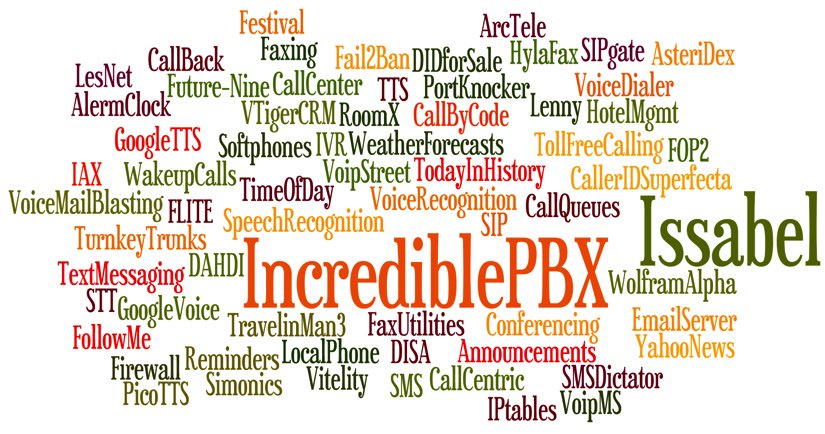
The Travelin’ Man 3 firewall is installed and configured as part of the install. It whitelists certain IP addresses and blocks everyone else from even seeing your server on the Internet. For this reason, it is critically important that you perform the Incredible PBX install using SSH or Putty from a PC that you will use to manage your Issabel server. Otherwise, you risk locking yourself out of your own server. Whitelisted IP addresses include the Issabel server itself, the public and private IP addresses of your desktop PC, all non-routable, private LAN addresses, and the Nerd Vittles collection of recommended SIP hosting providers. You can add as many additional providers or users to the whitelist using the simple tools provided as part of the install and further documented below. Do NOT activate Issabel’s firewall.
As part of the install process, you’ll be prompted during both passes to create a password for MySQL/MariaDB and an admin password for the Issabel web GUI. The MySQL password MUST be passw0rd (with a zero), or you will get a permanent mess. The admin password can be anything you like. Passwords can be updated by running /root/admin-pw-change. Many of the Incredible PBX apps depend upon this MySQL password so don’t change it. Your MySQL databases remain secure and can only be accessed on localhost or after a successful root login to your server from a whitelisted IP address.
Begin the Incredible PBX install by logging into your Issabel server as root from a desktop PC using SSH or Putty and execute the following commands:
cd /root wget http://incrediblepbx.com/IncrediblePBX11-Issabel4.sh chmod +x IncrediblePBX11-Issabel4.sh ./IncrediblePBX11-Issabel4.sh
Introducing the (new) Travelin’ Man 3 Firewall
Issabel 4 includes an IPtables firewall component. Do NOT activate it because Incredible PBX includes its own preconfigured IPtables firewall, better known as Travelin’ Man 3. With the Issabel 4 firewall, the administrator is responsible for setting all of the firewall rules. With Travelin’ Man 3, all the heavy lifting is done for you. The design is also markedly different. Issabel 4 opens ports which you define, but it gives worldwide access to those ports by any user. Travelin’ Man 3 employs a WhiteList rather than opening ports for everyone. If you’re on the WhiteList, you get access to the limited collection of ports assigned to that IP address. If you’re not on the WhiteList, you cannot even see the Issabel PBX from the Internet. For those without remote telephones or traveling employees, this provides total protection of your server with virtually no further firewall management.
If you have remote users of your PBX or if you wish to deploy softphones on mobile devices and rely upon WiFi facilities at random locations, Travelin’ Man 3 provides several utilities to assist. If the remote users have static IP addresses, then those IP addresses can be added to the WhiteList by running /root/add-ip. Better yet, a NeoRouter VPN is provided that lets remote users access Issabel using NeoRouter private LAN addresses that already are WhiteListed as part of the installation process. These require little to no configuration with static or dynamic IP addresses even when switching between WiFi networks. For those with dynamic IP addresses and no VPN, FQDNs can be assigned using a service such as dyn.com and a dynamic DNS client can be loaded on the smartphone to keep the current IP address synchronized with the FQDN. On the Incredible PBX side, these FQDNs can be added using /root/add-fqdn, and the IP addresses will be updated automatically every 10 minutes. The final option to provide remote users the 3-digit PortKnocker codes from knock.FAQ and let them automatically whitelist their own IP addresses by running the PortKnocker client from any smartphone or Linux server. When the Issabel server detects a successful knock sequence, the source IP of the knock sequence is whitelisted until the next reload of the firewall. If an administrator prefers to allow permanent additions to the WhiteList that survive a reboot or restart of the firewall, the administrator need only run the following command one time: iptables-knock activate. WhiteListed entries can be removed using the /root/del-acct utility. Further details on the new Travelin’ Man 3 design are available here.
Update: The July Issabel ISO introduced a quirk into our Travelin’ Man 3 setup. For a reason that we have not yet tracked down, it is no longer possible to whitelist an IP address and use that address to access the Issabel GUI with a browser. Until we can track down the problem, we have modified the security methodology to access the Issabel web GUI. While we have opened port 443 for public access, we have added another layer of security by requiring Apache htaccess credentials before you can access any web site on your Issabel server. As the last step of the Incredible PBX installation procedure, you will be prompted to enter your admin password again. The username admin and the admin password are used BOTH for Apache authentication AND Issabel GUI authentication. Should you ever need to change your Issabel GUI admin password using /root/admin-pw-change, you also will need to execute the following command to change the admin password for Apache authentication: htpasswd -c /etc/pbx/wwwpasswd admin.
Setting Up a Softphone with Issabel 4
If you’re a Mac user, you’re lucky (and smart). Download and install Telephone from the Mac App Store. Start up the application and choose Telephone:Preference:Accounts. Click on the + icon to add a new account. To set up your softphone, you need 3 pieces of information: the IP address of your server (Domain), and your Username and Password. You can decipher your server’s IP address by running pbxstatus. If you wish to use one of the preconfigured extensions (701 and 702), you’ll find the randomized passwords in /root/passwords.FAQ. Now copy or cut-and-paste your Username and Password into the Accounts dialog of the Telephone app. Click Done when you’re finished, and your new softphone will come to life and should show Available. Dial the IVR (D-E-M-O) to try things out. With Telephone, you can use over two dozen soft phones simultaneously.
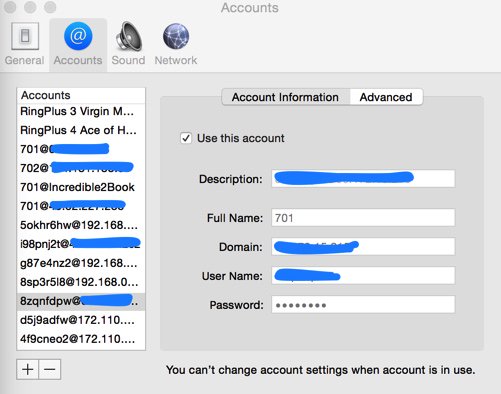
For everyone else, we recommend the YateClient softphone which is free. Download it from here. Run YateClient once you’ve installed it and enter the credentials for the Issabel extension. You’ll need the IP address of your server plus your extension number and password associated with either the 701 or 702 extension.
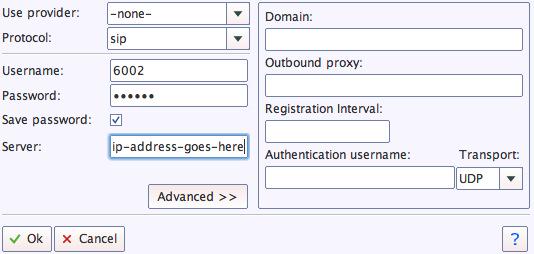
Configuring Google Voice Natively or Using Simonics
Everybody likes free calling, and nobody does it better than Google. Will it last? Well, the naysayers (including me) have been predicting its demise for over 5 years. Yet it keeps on ticking. If you live in the U.S. and want to take advantage of free calls in the U.S. and Canada, you’d be crazy not to deploy a Google Voice trunk on your PBX. Voice quality is near perfect. And the price is right.
The original release of Incredible PBX for Issabel did not support Google Voice trunks so we suggested an intermediary to provide the functionality through a SIP gateway. It works flawlessly using OAuth 2 password authentication, but it’ll set you back $5. If you prefer free, we’ve added the original Google Voice plain-text password solution from the FreePBX® 2.11 days in the latest Incredible PBX release using the July Issabel ISO. It is far from perfect. While you can make and receive calls and faxes to and from Issabel extensions, you cannot direct incoming calls to an IVR because of an old NAT quirk in Asterisk 11. If this isn’t a problem for you, keep reading. Otherwise, skip down to the Simonics tutorial below after completing the initial Google Voice setup which follows.
Here are the initial setup steps on the Google side:
1. Set up a dedicated Gmail and Google Voice account to use exclusively for this new SIP gateway. Head over to the Google Voice site and register. You’ll need to provide a U.S. phone number to verify your account by either text message or phone call.
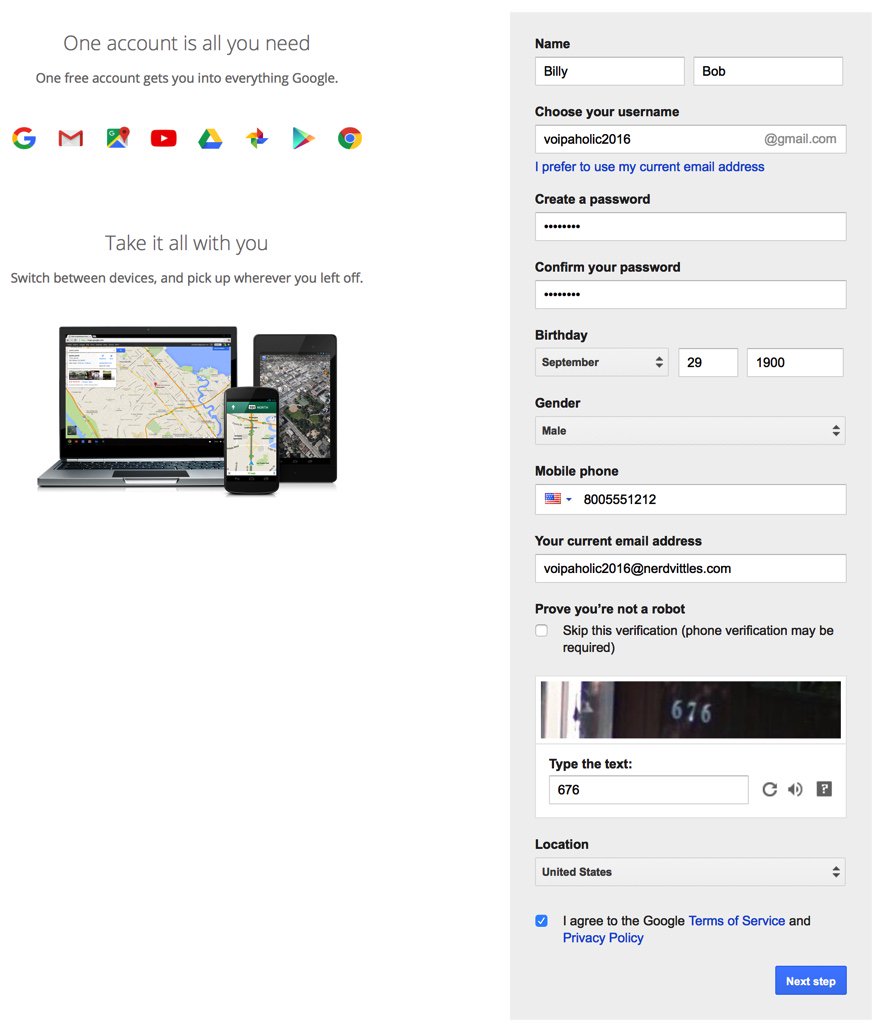
2. Once you have verified your account by entering your verification code, you’ll get a welcome message from Mr. Google. Click Continue to Google Voice.
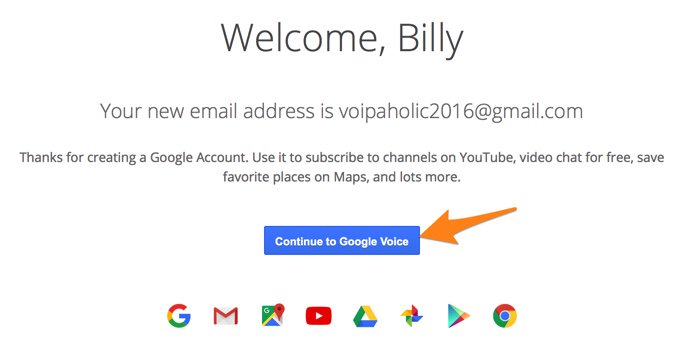
3. Provide an existing U.S. phone number for verification. It can be the same one you used to set up your Google account in step #1.
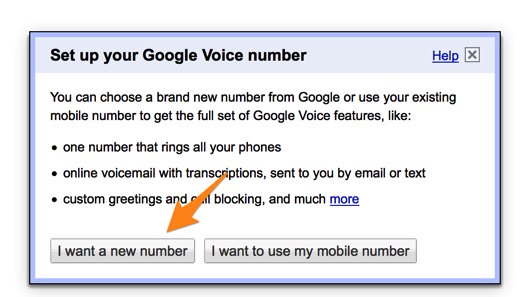
4. Once your phone number has been verified, choose a DID in the area code of your choice.
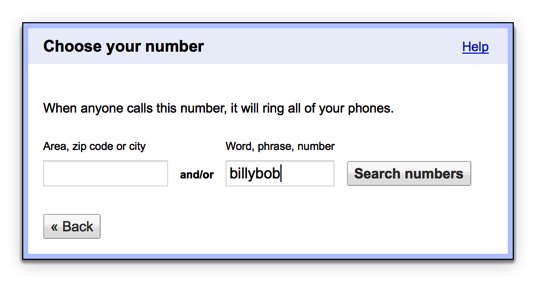
5. When your DID has been assigned, click the More icon at the bottom of the left column of the Google Voice desktop. Click Legacy Google Voice. Now click the Settings icon on your legacy Google Voice desktop. Make certain that Forward Calls to Google chat is checked and disable calls to your forwarding number. Click on the Calls tab and select Call Screening:OFF, CallerID (Incoming):Display Caller’s Number, and Global Spam Filtering:checked. The remaining entries should be blank.
6. Google Voice configuration is now complete. Sign out of your Google Voice account.
The Native Google Voice Solution using FreePBX Motif Module. Here’s a quick thumbnail of the steps to put all the pieces in place using the FreePBX Google Voice/Motif module. First, we set up a Google Voice account at Google as documented above. Next, we’ll set up the Google Voice account in the Issabel GUI to activate the Google Voice trunk. Next, we’ll add an Incoming Route to tell Issabel how to process Google Voice calls. Then we need to tell Google to relax the rules on use of plain text passwords. And, finally, we’ll restart Asterisk from the Linux CLI.
1. Login to the Issabel web interface with your admin password and choose PBX:PBX Config:Google Voice. Enter your Google Voice account name, password, and 10-digit phone number. Be sure to check all three boxes to Add a Trunk, Add an Outbound Route, and Send Unanswered Calls to Google Voicemail. Click Submit and then reload your dialplan when prompted.
2. Configure an Inbound Route for your incoming Google Voice calls. Click Inbound Routes in the PBX Configuration Menu. Then click Add Incoming Route and enter a Description for the route and enter the DID Number using your 10-digit Google Voice number. If you want to activate CNAM (CallerID Name) lookups, choose OpenCNAM from the Source list. Choose an appropriate Destination for the calls from the pull-down menu of choices. Use only an extension or a ring group. Then SAVE your settings and reload dialplan. To activate fax detection, change Detect Faxes to YES, Detection type to SIP, Detection time to 4, and Destination to Extension 329 (F-A-X). Click Submit and then reload your dialplan again.
3. On the Google site, login into your Google Voice account again. Then follow this link to Enable Less Secure Apps. Then follow this link to activate the Google Voice Reset Procedure. Now log out of your Google Voice account.
4. Login to your Issabel server with SSH/Putty as root and restart Asterisk: amportal restart
5. Now connect a SIP phone to extension 701 and place a call to any number in the U.S. or Canada.
6. Once you have placed an outbound call, incoming calls should work by dialing your Google Voice number from any phone. If you have trouble getting Google to answer the call, this is fairly typical. Try adjusting the NAT settings for your extension from YES to NEVER and place another call. Then change then back to NAT = yes, and you should be good to go.
7. For additional Google Voice trunks, rinse and repeat.
The Simonics GV-SIP Gateway Solution. Here’s the quick thumbnail of the steps to put all the pieces in place. First, we set up a Google Voice account at Google as documented above. Next, we’ll set up an account at the Simonics site to link our Google Voice account to the Simonics SIP Gateway. Then we’ll plug our Simonics SIP credentials into the preconfigured Simonics trunk on Incredible PBX. Finally, we’ll add Incoming and Outgoing Routes to tell Issabel how to process Google Voice calls.
Now you’re ready to set up an account on the Simonics site. With this Nerd Vittles link, there’s a one-time fee of $4.99.
1. Start by registering your new Google account.
2. After paying the $4.99 registration fee via PayPal, proceed through the setup process to link your Google Voice account and 11-digit Google Voice phone number to the Simonics SIP Gateway.
3. You then will be provided your SIP username and password as well as the gateway address, gvgw.simonics.com, to use in building your SIP trunk on your Issabel PBX.

4. If your SIP credentials ever get compromised, regenerate your password by logging back into the Simonics GW site.
Now it’s time to configure your Simonics trunk in Incredible PBX for Issabel. Start by logging into the Issabel web interface as admin with your admin password from above. Next, click PBX:PBX Configuration in the left Issabel menu. Click Trunks:Simonics-GV in the PBX Configuration menu. The Simonics-GV trunk template will display:
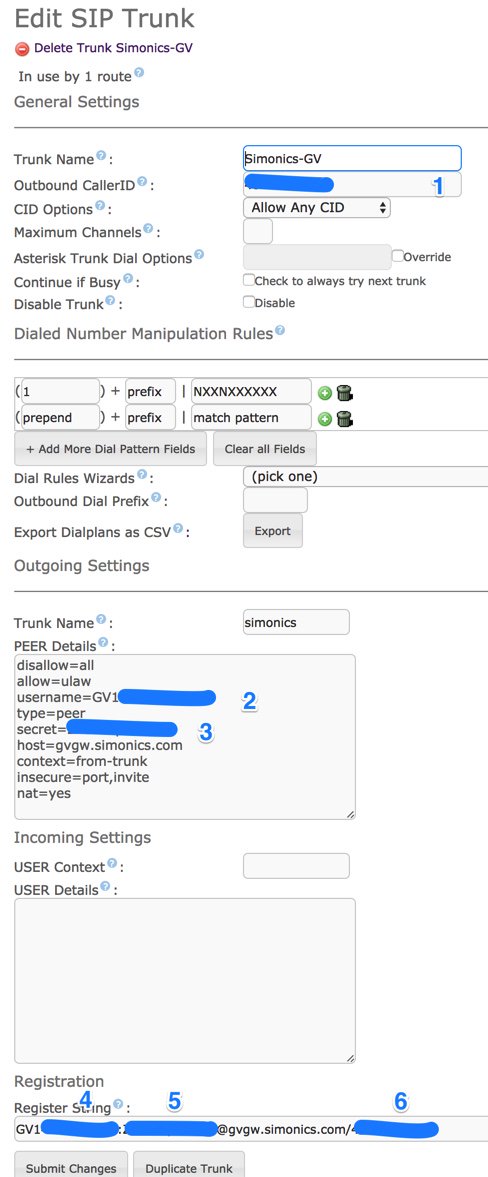
1. Untick the Disable Trunk check box.
2. In Outbound CallerID, insert your 10-digit Google Voice number.
3. In username, insert GV1 followed by your 10-digit Google Voice number.
4. In secret, insert your Simonics SIP password.
5. In the Registration String, insert GV1 followed by your 10-digit Google Voice number followed by a colon (:)
6. In the Registration String after the colon, insert your Simonics SIP password.
7. In the tail of the Registration String after the slash (/), insert your 10-digit Google Voice number.
8. Click Submit Changes and then Reload the Dialplan when prompted.
Now you’re ready to configure an Outbound Route for your Google Voice calls. Click Outbound Routes in the PBX Configuration Menu. Then click Add Route and fill out the form as shown below, save your settings, and reload the dialplan.
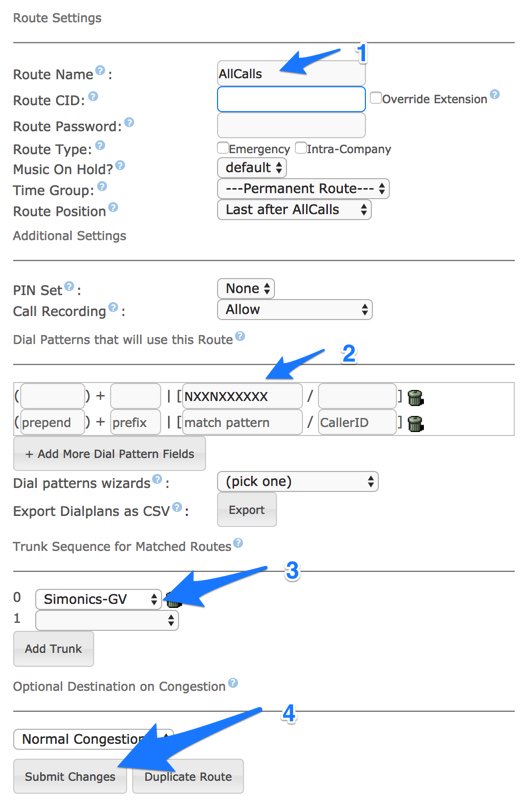
Finally, let’s configure an Inbound Route for your incoming Google Voice calls. Click Inbound Routes in the PBX Configuration Menu. Then click Add Incoming Route and enter a Description for the route and enter the DID Number using your 10-digit Google Voice number. If you want to activate CNAM (CallerID Name) lookups, choose OpenCNAM from the Source list. Choose an appropriate Destination for the calls from the pull-down menu of choices, e.g. extension, ring group, IVR, etc. Then SAVE your settings and reload dialplan.
Your Google Voice trunk through the Simonics SIP Gateway should now be working. You can verify this by entering sip show registry in the Asterisk CLI. Place a test call from a softphone connected to your Issabel PBX by dialing a 10-digit number. Then place a call to your Google Voice number from a mobile phone or home/office phone. The Asterisk CLI displays progress of calls by activating it from Linux CLI: asterisk -rvvvvvvvvvv
If you have trouble getting Google Voice to work (especially if you have previously used your Google Voice account from a different IP address), try this Google Voice Reset Procedure. It usually fixes connectivity problems. If it still doesn’t work, enable Less Secure Apps using this Google tool.
If you want to display your primary phone number on the pbxstatus dialog, simply enter the number in /etc/pbx/.phone.
Adding Speech Recognition Support to Incredible PBX
To support many of our applications, Incredible PBX has included Google’s speech recognition service. These applications include AsteriDex Voice Dialing by Name (411) and Wolfram Alpha for Asterisk (4747), all of which use Lefteris Zafiris’ terrific speech-recog AGI script. Unfortunately (for some), Google now has tightened up the terms of use for their free speech recognition service. Now you can only use it for "personal and development use." If you meet those criteria, keep reading. Here’s how to activate speech recognition on Incredible PBX. Don’t skip any steps!
If you like Siri, you’ll love Wolfram Alpha. To use Wolfram Alpha by phone, you first must obtain a free Wolfram Alpha APP-ID. Then issue the following command replacing APP-ID with your actual ID. Don’t change the yourID portion of the command:
sed -i "s|yourID|APP-ID|" /var/lib/asterisk/agi-bin/4747
Now you’re ready to try out the speech recognition apps. Dial 411 and say "American Airlines" to be connected to American.
To access Wolfram Alpha by phone, dial 4747 and enter your query, e.g. "What planes are overhead now?" Read the Nerd Vittles tutorial for additional examples and tips.
Configuring the Issabel Fax Server
Incredible PBX for Issabel includes turnkey fax support with Issabel. Once you have added a trunk that supports VoIP faxing (HINT: Google Voice trunks work great!), fax configuration with Issabel only takes a minute. Start by logging into the Issabel web interface as admin. First, navigate to PBX:PBX Configuration:Extensions:Fax and obtain your password for extension 329. Next, navigate to Fax:Virtual Fax:New Virtual Fax. Fill in the form as shown below using your actual email address and phone number for receiving faxes as well as your actual extension 329 secret. Then click SAVE. Assuming you typed your secret correctly, you will see a status notification showing virtual fax machine "Running and idle on ttyIAX1."

Assuming you already have set up a Google Voice trunk as outlined above, the next step is to modify the Inbound Route for this trunk to support fax detection. In that way, incoming fax calls will automatically be redirected to extension 329 and the received faxes will be emailed to you in PDF format. Set the email address in Fax:Fax Master. In addition, the faxes can be downloaded and managed from Fax:Virtual Fax:Fax Viewer. Modify your Inbound Route to match the #3 settings shown below. Then save/reload your changes.
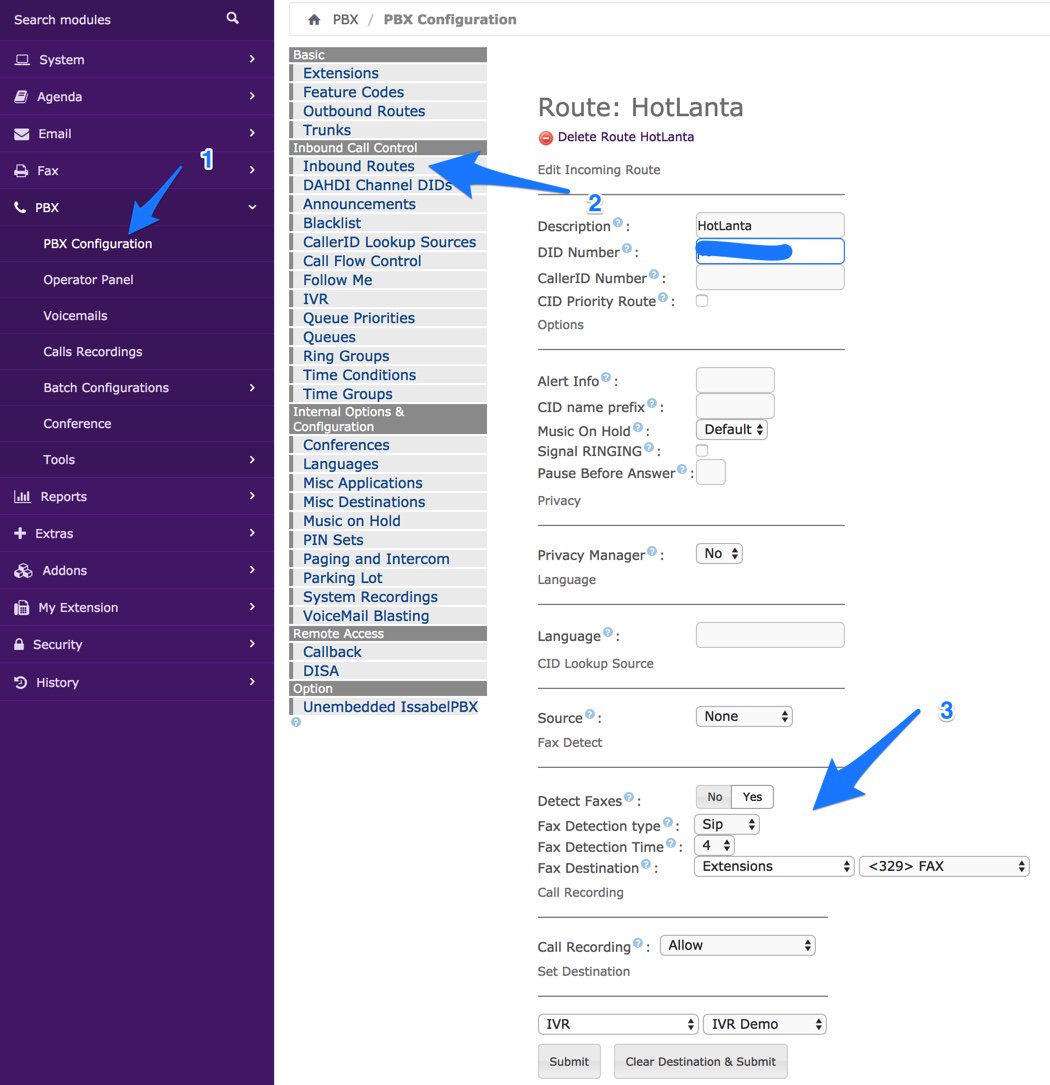
To receive the incoming faxes by email, navigate to Fax:Fax Master and enter your email address. Then click SAVE.
The final step is to designate the IP addresses of those authorized to send faxes using Issabel. Navigate to Fax:Fax Clients and specify the public and private IP addresses (one per line) authorized to send faxes. Then click SAVE. Hylafax clients can be used remotely, or you can use the web utility included with Issabel: Fax:Virtual Fax:Send Fax.

The best way to test things out is to send yourself a test fax. FaxZERO lets you send 5 free faxes of up to 3 pages every day. Give it a whirl.
To send a fax out from your server from the Linux CLI using either a text document or PDF file, the syntax looks like the following:
sendfax -n -d 8005551212 smsmsg.txt
Sampling Other Incredible PBX Applications
As installed, Incredible PBX includes dozens of additional applications for Asterisk. Here’s how to sample some of them using a softphone connected to your Issabel PBX. A good place to start is Allison’s Demo IVR (dial D-E-M-O) using any phone connected to your PBX:
Nerd Vittles Demo IVR Options
1 – 411 -Call by Name (say "American Airlines")
2 – 2663 – MeetMe Conference
3 – 4747 – Wolfram Alpha
4 – 53669 – Lenny (The Telemarketer’s Worst Nightmare)
5 – 951 – Today’s News Headlines
6 – 947 – Weather Forecast (enter a 5-digit ZIP code)
7 – 86329 – Today in History
8 – 701 – Speak to a Real Person
For ODBC demos, dial 222 and enter 12345 for the employee number for a sample database application. Or dial 223 for a sample ODBC dialer using AsteriDex. Enter 263 (first three letters of American Airlines) to place the call. Sample dialplan code is stored in /etc/asterisk/odbc.conf. Dial L-E-N-N-Y (53669) to call or forward telemarketer calls to Lenny. Dial T-I-M-E (8463) for Time of Day. Dial *88HHMM to set an Alarm for HH:MM where HH is the hour of the day in military time. Dial C-O-N-F (2663) for MeetMe conference. Conference credentials are in /root/passwords.FAQ. Voice Dialer (411) works with any database entry in AsteriDex. Access AsteriDex with a browser at https://Issabel-IP-Address/asteridex4. Telephone Reminders can be scheduled by phone (123) or via the web: https://Issabel-IP-Address/reminders. Sample code for the FLITE, GoogleTTS, and PicoTTS engines is in 951 (Yahoo News) context of /etc/asterisk/extensions_custom.conf. All of your FreePBX "old favorites" including blacklists, call transfers and forwarding, dictation, recordings and more are still available as well: PBX:PBX Config:Feature Codes.
Update: We’ve added Allison’s Demo IVR to our own Issabel server at Vultr ($2.50/mo.)1 so you can judge the call quality and feature set for yourself. You can even send us a fax or SMS message if you’d like to try out those features: 
For VoIP callers, use this free SIP URI: 1015954772235642@tampa.voip.ms
Published: Monday, July 10, 2017 Updated: Tuesday, July 25, 2017
 Support Issues. With any application as sophisticated as this one, you’re bound to have questions. Blog comments are a difficult place to address support issues although we welcome general comments about our articles and software. If you have particular support issues, we encourage you to get actively involved in the PBX in a Flash Forum. It’s the best Asterisk tech support site in the business, and it’s all free! Please have a look and post your support questions there. Unlike some forums, the PIAF Forum is extremely friendly and is supported by literally hundreds of Asterisk gurus and thousands of users just like you. You won’t have to wait long for an answer to your question.
Support Issues. With any application as sophisticated as this one, you’re bound to have questions. Blog comments are a difficult place to address support issues although we welcome general comments about our articles and software. If you have particular support issues, we encourage you to get actively involved in the PBX in a Flash Forum. It’s the best Asterisk tech support site in the business, and it’s all free! Please have a look and post your support questions there. Unlike some forums, the PIAF Forum is extremely friendly and is supported by literally hundreds of Asterisk gurus and thousands of users just like you. You won’t have to wait long for an answer to your question.

Need help with Asterisk? Visit the PBX in a Flash Forum.
Special Thanks to Our Generous Sponsors
FULL DISCLOSURE: ClearlyIP, Skyetel, Vitelity, DigitalOcean, Vultr, VoIP.ms, 3CX, Sangoma, TelecomsXchange and VitalPBX have provided financial support to Nerd Vittles and our open source projects through advertising, referral revenue, and/or merchandise. As an Amazon Associate and Best Buy Affiliate, we also earn from qualifying purchases. We’ve chosen these providers not the other way around. Our decisions are based upon their corporate reputation and the quality of their offerings and pricing. Our recommendations regarding technology are reached without regard to financial compensation except in situations in which comparable products at comparable pricing are available from multiple sources. In this limited case, we support our sponsors because our sponsors support us.
 BOGO Bonaza: Enjoy state-of-the-art VoIP service with a $10 credit and half-price SIP service on up to $500 of Skyetel trunking with free number porting when you fund your Skyetel account. No limits on number of simultaneous calls. Quadruple data center redundancy. $25 monthly minimum spend required. Tutorial and sign up details are here.
BOGO Bonaza: Enjoy state-of-the-art VoIP service with a $10 credit and half-price SIP service on up to $500 of Skyetel trunking with free number porting when you fund your Skyetel account. No limits on number of simultaneous calls. Quadruple data center redundancy. $25 monthly minimum spend required. Tutorial and sign up details are here.
 The lynchpin of Incredible PBX 2020 and beyond is ClearlyIP components which bring management of FreePBX modules and SIP phone integration to a level never before available with any other Asterisk distribution. And now you can configure and reconfigure your new Incredible PBX phones from the convenience of the Incredible PBX GUI.
The lynchpin of Incredible PBX 2020 and beyond is ClearlyIP components which bring management of FreePBX modules and SIP phone integration to a level never before available with any other Asterisk distribution. And now you can configure and reconfigure your new Incredible PBX phones from the convenience of the Incredible PBX GUI.
 VitalPBX is perhaps the fastest-growing PBX offering based upon Asterisk with an installed presence in more than 100 countries worldwide. VitalPBX has generously provided a customized White Label version of Incredible PBX tailored for use with all Incredible PBX and VitalPBX custom applications. Follow this link for a free test drive!
VitalPBX is perhaps the fastest-growing PBX offering based upon Asterisk with an installed presence in more than 100 countries worldwide. VitalPBX has generously provided a customized White Label version of Incredible PBX tailored for use with all Incredible PBX and VitalPBX custom applications. Follow this link for a free test drive!
 Special Thanks to Vitelity. Vitelity is now Voyant Communications and has halted new registrations for the time being. Our special thanks to Vitelity for their unwavering financial support over many years and to the many Nerd Vittles readers who continue to enjoy the benefits of their service offerings. We will keep everyone posted on further developments.
Special Thanks to Vitelity. Vitelity is now Voyant Communications and has halted new registrations for the time being. Our special thanks to Vitelity for their unwavering financial support over many years and to the many Nerd Vittles readers who continue to enjoy the benefits of their service offerings. We will keep everyone posted on further developments.
Some Recent Nerd Vittles Articles of Interest…
- Some of our links refer users to providers that support Nerd Vittles through referral fees or advertising. These funds help cover the costs of our blog. We never recommend particular products solely to generate revenue. However, when pricing is comparable or particular features warrant our recommendation, we support these vendors and deeply appreciate their financial support of our software development efforts. [↩]
3CX in the Cloud: 8 Great Ways to Secure Your Server

Now that many of you have taken advantage of the opportunity to deploy a free 3CX server, it seemed like an opportune time to share what we’ve learned while deploying 3CX on hosted platforms in the cloud. If you’ve followed our Nerd Vittles adventures over the years, you already know that our number one consideration with any PBX deployment is security. Without that, you’re just paying somebody else’s phone bill. While 3CX is extremely secure as delivered, once you choose a cloud-based platform, it’s a new ballgame. There is no 3CX firewall sitting between your PBX and the Internet.
We hear some of you saying, "I love Asterisk. Why would I want to move to 3CX?" The short answer is don’t move, add a new 3CX server to supplement your existing Asterisk® infrastructure. Why? Because the 3CX Clients for Windows, Macs, iOS, and Android are incredibly compelling. You can make a connection from anywhere using WiFi or cellular infrastructure and make crystal clear calls with zero hassles. Better yet, folks can reach you on your mobile phone from anywhere in the world at zero cost by dialing your SIP URI using any SIP device including SIP softphones and other 3CX Clients. And the 3CX Client is literally plug-and-play. Send the welcome email for the extension you wish to activate on the 3CX Client, and in one-click your 3CX Client is automatically configured and on line. By interconnecting your 3CX server with your existing Asterisk infrastructure, you get the best of both worlds without the messy NAT and firewall problems that were daily fare using Asterisk alone. But we’re getting ahead of ourselves, let’s get your 3CX server in the Cloud properly secured before moving on to the fun stuff.
Five years ago, we first introduced our Failsafe PBX Security Tips to Sleep Like a Baby. That’s well worth a careful read before we begin. For today, we’ll be implementing most of the Travelin’ Man 3 Security Model with a few tweaks to take advantage of existing 3CX security features. We’ll walk you through (1) choosing a cloud platform, (2) deploying the IPtables Linux firewall, (3) implementing a WhiteList to hide your server from those that don’t need access, (4) installing PortKnocker to make it easy for end-users to give themselves access to your PBX, (5) configuring FQDNs and implementing dynamic DNS updates for remote users, (6) setting up a BlackList to complement 3CX’s existing Anti-Hacking mechanisms, (7) deploying IPset to facilitate blocking entire countries from accessing your server, and (8) protecting SSH by setting up Fail2Ban and changing ports.
Let’s spend a moment considering the best security methodology for your cloud-based server. The short answer is IT DEPENDS. If all of your users are situated in the same location and never travel and you don’t care to enable SIP URI calling from anywhere in the world to save on phone costs, then the solution is pretty easy. We can lock your server down to the public IP address of your private LAN, and nobody else will ever see your server. Once you add users outside your home office, things get more complicated. If they are all sitting behind local routers with public IP addresses that are static, things are still fairly straightforward. We can whitelist all of the static IP addresses, and again nobody else will see your 3CX server. If you have users that travel for a living or need 3CX Client connectivity from their smartphones or from PCs at various locations that only have dynamic IP addresses, then things get more complicated. You can take your chances and expose SIP communications ports while locking down other access, or you can lock down everything, assign FQDNs to each user, and use dynamic DNS clients running on Android or iOS devices or local PCs to regularly update IP addresses of users in the firewall whitelist.
Another option that we use when traveling is PortKnocker which will be installed as part of our Travelin’ Man 3 security suite. The way this works is you send a single packet to three different TCP ports on your server using a predefined sequence of 3 port numbers. When there is a match, the server will automatically whitelist your IP address. Then you can log into SSH or the Web portal or use a 3CX Client in the usual way. There are PortKnocker clients for smartphones (Android’s DroidKnocker and iOS PortKnock), or you can use the command line from a Linux server to immediately authorize remote access from any IP address. No firewall modification is required. By default, Travelin’ Man 3 temporarily authorizes IP address access until the next server reboot. But you can elect to permanently whitelist the IP addresses if desired. Again, all of this can be performed remotely by end-users without ever touching your server or calling upon assistance from an administrator.
Finally, we’ve provided utilities in /root to assist an administrator in whitelisting IP addresses (add-ip) or FQDNs (add-fqdn) as well as removing whitelisted entries (del-acct). In addition, if you prefer to leave your server exposed, we’ve included tools to blacklist IP addresses (add-blacklist), and our discussion below will provide some alternatives to secure SSH access. Whichever path you choose, just be aware that server security it totally your responsibility, not ours and not 3CX’s. We strongly recommend that you regularly monitor the Event Log in the 3CX Dashboard for security issues and attempted breaches. You then can make firewall adjustments to address the problems or to further lock down your server.
LEGAL DISCLAIMER: ALL OF THE SECURITY CODE WHICH FOLLOWS IS DISTRIBUTED AS IS AND PURSUANT TO THE GPL2 LICENSE. YOU AGREE TO ASSUME ALL RISKS BY USING THIS SOFTWARE. YOU ARE FREE TO MODIFY IT TO MEET YOUR REQUIREMENTS SO LONG AS YOU COMPLY WITH THE GPL LICENSE TERMS AVAILABLE HERE.
For today’s tutorial, we will cover both the WhiteList 3CX firewall methodology and the less secure BlackList alternative. We’ll walk you through exposing the necessary ports if you elect to use this relaxed security configuration for your server. Just be aware that it’s your phone bill at stake particularly if you have authorized calls to countries outside the location of your server as part of your 3CX setup.
1. Choosing a 3CX Cloud Platform
Here are a few things to consider when choosing a cloud platform for your 3CX server. Keep in mind that the cloud giants like Amazon charge for data bandwidth usage AND data storage AND processing cycles. Even though Amazon uses what are traditionally considered non-routable IP addresses internally, be advised that Amazon internally routes these private LAN addresses. What that means is that, if you have whitelisted private LAN addresses in the 172.16.0.0/12 range, you will expose your server to hacking attempts from anyone with an Amazon S3 account. For that reason coupled with the pricing structure, we recommend against using Amazon as your 3CX cloud platform.
We also recommend you stick with VPS hosting plans using the KVM architecture and avoid OpenVZ unless it’s hosted with Virtuozzo 7. The traditional shared kernel architecture of OpenVZ means you will forfeit the ability to use powerful tools such as IPset to blacklist country-wide IP addresses from countries such as China and Russia. Over 90% of the attacks we see on our web sites originate from IP addresses in just those two countries. Fortunately, the new Virtuozzo 7 implementations of OpenVZ support ipset. SSDnodes in Montreal is the provider we use.
The rest of the cloud platform equation comes down to balancing the feature set and performance against the cost. At the bottom of the barrel is CloudAtCost which offers lifetime cloud services for a one-time charge PLUS an annual maintenance charge. Performance and reliability range from awful to tolerable. As an experimental platform, it’s worth considering. For anything beyond that, don’t waste your time or money.
Our preferences in low-cost, moderate performance cloud platforms include OVH virtual private servers ($3.49/mo. for 2GB RAM, 10GB SSD, 100Mbps unlimited bandwidth, and DDoS protection), Vultr VPS ($5/mo. for 1GB RAM, 25GB SSD, 1TB bandwidth), and Digital Ocean ($5/mo. for 512MB RAM, 20GB SSD, 1TB bandwidth plus $10 usage credit). For high performance, long-term use, nobody beats our corporate sponsor, RentPBX.com, at $15/mo. with referral code: NOGOTCHAS.1
2. Deploying the IPtables Linux Firewall
We’ve taken the pain out of deploying IPtables as a 3CX firewall. Our Travelin’ Man 3 script for 3CX does the heavy lifting for you by installing and preconfiguring IPtables and a collection of other security components. There are two alternatives when running the installer. You can completely lock down your server and use a firewall whitelist to enable access from specified IP addresses or FQDNs. There are utilities to allow administrators and end-users to add their own addresses to the whitelist. The other option is to run 3CX without the whitelist functionality and employ blacklisting to reduce the exposure of your server. This obviously increases the security risks but reduces the administrative burden on administrators and end-users. And, as you probably know, 3CX includes some security mechanisms to block or reduce attacks on your server. A third option using 3CX Clients or SBCs in networks that prevent VoIP calls is to deploy 3CX’s VPN-like Tunnel. This is well documented in this server tutorial and this client tutorial. It’s worth a careful look if you’re in a country that blocks VoIP calls, and it works with either TM3 firewall configuration. A fourth option which we will save for another day is to employ virtual private networks such as OpenVPN and NeoRouter. With VPNs, there’s more work on the front end but less day-to-day administration once properly configured.
If you don’t have widely scattered users and traveling users that need to employ 3CX Clients, the WhiteList option is far preferable. It sets up a WhiteList of devices that are authorized to access your PBX. Nobody else can even see the server on the Internet. To get started, log into your server as root using SSH or Putty. Be sure to login from a computer that will be used to manage your server so that this computer’s IP address gets whitelisted. You don’t want to lock yourself out of your own server! Then issue the following commands at the Linux prompt to run the TM3 installer, accept the license agreement, and choose either the WhiteList or BlackList option when prompted:
cd / wget http://incrediblepbx.com/tm3-3cx.tar.gz tar zxvf tm3-3cx.tar.gz rm -f tm3-3cx.tar.gz cd /root ./tm3-3cx.sh
When the installer finishes, press ENTER. You now have a functioning 3CX firewall with IPtables and Fail2Ban functionality to protect SSH logins from hacking attempts, IPset to block server access from certain countries, PortKnocker to facilitate remote user access to servers employing a WhiteList, and a collection of utilities in /root to facilitate WhiteListing and BlackListing of IP addresses and FQDNs by administrators.
3. Implementing the 3CX Firewall WhiteList
For the more technical types, here’s an overview of how the IPtables firewall is configured and functions. Currently, only IPv4 is protected. The basic setup is handled in /etc/iptables/rules.v4 by making a copy of rules.v4.tm3 and whitelisting 3 IP addresses: your server, your user PC from which you logged into SSH, and your public IP address. Additional whitelist entries are added using add-ip or add-fqdn in /root. Or end users can whitelist themselves using the PortKnocker credentials stored in /root/knock.FAQ. IPtables ALWAYS must be restarted/reloaded using the command: iptables-restart. This assures that all necessary components are reloaded including the base rules.v4 IPtables config plus the custom config in /usr/local/sbin/iptables-custom plus Fail2Ban. An administrator can remove whitelisted entries using /root/del-acct using the *.iptables filename associated with the entry to be removed. PortKnocker whitelist entries are stored by creation date.
Two templates for the TM3 custom configuration are stored in /usr/local/sbin. The WhiteList is iptables-custom.secure. The BlackList is iptables-custom.insecure. As part of the install, one or the other is copied into iptables-custom for use with your IPtables firewall. The code is well documented so that administrators can easily make modifications to support your own requirements. Simply rerun the tm3-3cx.sh installer once you have made changes, and your server will be reconfigured. Be advised that any previously added whitelist entries should be removed (/root/*.iptables) BEFORE rerunning the installer as these entries will not be replicated.
4. Using PortKnocker with the TM3 Firewall
There are two ways to use PortKnocker for end user management of the WhiteList. The default methodology is to temporarily WhiteList qualifying IP addresses whenever a successful port knock is performed from any remote site. This WhiteList addition to the firewall lasts only until the firewall is restarted with iptables-restart or the server is rebooted. For a mobile workforce, this is probably the preferable alternative with frequently updated remote IP addresses. The other alternative is to permanently add successful PortKnock IP addresses to the iptables-custom whitelist. The administrator can activate this by running the following command: iptables-knock activate. As with other WhiteList additions, these are stored in /root as *.iptables. To use PortKnocker, remote users will need the secret knock credentials stored in /root/knock.FAQ. Should you ever need to modify these codes when an employee is fired, simply edit /etc/knockd.conf and change the codes. Remember to revise /root/knock.FAQ with the new codes. Then restart PortKnocker: /root/knock-tester.sh.
5. Configuring Dynamic DNS for End Users
Here’s an easier way to set up remote users whose IP addresses regularly change either because of an ISP’s dynamic IP addressing scheme or because the user travels or frequently uses 3CX Clients from a smartphone. The trick here is to assign a fully-qualified domain name (FQDN) to each remote user’s device and then deploy a dynamic DNS update application on their device to keep the user’s current IP address in sync with their FQDN. As part of the TM3 implementation on 3CX, we included the /root/ipchecker script which checks for IP address changes every 10 minutes and updates the firewall whitelist accordingly. All that is required from the administrator is running /root/add-fqdn once for each remote user. Everything else is automatic on the 3CX server and the end user device.
There are a number of Dynamic DNS providers. Some are free and others have a modest annual fee. When it comes to DNS service, you get what you pay for. And our favorite remains dyndns.com. There are hundreds of domain names from which to choose, and there are update clients for most client platforms: Windows, Mac, Linux, iOS, and Android.
The setup procedure is straight-forward. (1) Choose a FQDN for each of your users on the dynamic DNS provider site. (2) Install and configure the DNS updater on each client device. (3) Run /root/add-fqdn on your 3CX server to add the FQDNs of each user to the TM3 WhiteList. (4) Restart IPtables: iptables-restart.
6. Implementing BlackLists with the TM3 Firewall
If an administrator elects NOT to deploy the 3CX firewall with a WhiteList and opts for the open 3CX firewall, then there are some additional steps to assure that your server remains secure. First, you’ll want to carefully monitor the 3CX Event Log in the 3CX web dashboard. When you spot hacking attempts that are being temporarily blocked by your 3CX server, immediately add them to your IPtables BlackList: /root/add-blacklist ipaddress. Thereafter, those users will no longer be able to access your server. After adding less than a handful of entries, our exposed server has not seen any further hacking attempts. YMMV!
7. Configuring Country Blocking with IPtables
The primary reason individual blacklist entries are unnecessary is because the TM3 installer automatically configures IPset to block access from a number of problematic countries. You can review these in /etc/block-china.sh and make modifications based upon your own requirements. Keep in mind that, if you add or remove countries from the script, you will need to add/remove the same entries in /usr/local/sbin/iptables-custom to assure that all of the countries you intend to block are assimilated into your firewall’s blacklist. Then reload the IPset tables and restart IPtables with this command: /etc/block-china.sh. To begin, you’ll need to decipher the country code for additional countries you wish to block. The country listing with codes is available here. The IPset country zones are available here.
The syntax for a new country addition in /etc/block-china.sh looks like this with the country name inserted in lines 1 & 4 and the country code inserted in lines 2 & 3:
/sbin/ipset -N china hash:net rm cn.zone /usr/bin/wget -P . http://www.ipdeny.com/ipblocks/data/countries/cn.zone for i in ; do /sbin/ipset -A china ; done
The blacklist entries in /usr/local/sbin/iptables-custom look like this using the country name from above:
/sbin/iptables -A INPUT -p tcp -m set --match-set china src -j DROP /sbin/iptables -A INPUT -p udp -m set --match-set china src -j DROP
None of the country modifications take effect until you reload the IPset tables and restart IPtables. Both are accomplished by running /etc/block-china.sh.
8. Hardening SSH with 3CX in the Cloud
If you chose to implement the TM3 WhiteList option, SSH on your 3CX server is insulated from SSH attacks because the bad guys can’t see or access port 22 on your server. However, if you’re using the non-WhiteList approach with IPtables, then some additional safeguards to secure SSH are appropriate. As part of the TM3 security suite, Fail2Ban was installed to block repeated attempts to login to SSH. While this offers some protection, be advised that Fail2Ban scans logs and, as such, requires a sufficient time slice of processing power to complete the task regularly. Some of the more vicious hacking attempts originate from extremely powerful server platforms that can monopolize processor resources thereby depriving Fail2Ban of the necessary horsepower to adequately protect your server from brute force SSH attacks. The most important thing you can do to protect SSH on your server is to regularly review /var/log/auth.log for hacking attempts and block those IP addresses using the add-blacklist script.
The most effective way to configure SSH access is to deploy key-based authentication using cryptographically secure keys. Once enabled and tested, be sure to remove the ability to login using your root password. But be aware that removing root password access will mean that you cannot login to your server from multiple devices without copying your private key to every device from which you wish to obtain access. An excellent tutorial that will walk you through the basic implementation procedure is available from Digital Ocean.
The other effective way to minimize SSH attacks is to change the default access port on your server from port 22 to some other TCP port above 1024. While there are arguments against this approach, if you have a dedicated IP address assigned to your server, the likelihood of a bad guy hijacking your IP address and setting up a script to fake SSH behavior and surreptitiously collect your passwords is extremely remote. Most of the bad guys use toolkits that target port 22 for brute force SSH attacks. By changing the port, you cut your vulnerability by about 99 per cent. Here’s how. First, edit /etc/ssh/sshd_config. Change the line near the top of the file from Port 22 to some port number above 1024. If the line is commented out with #, remove the #. Second, edit /etc/iptables/rules.v4. On or about line 27, change 22 to the port number you assigned in the first step. Third, edit /etc/fail2ban/jail.conf. Scroll down to the [ssh] section of the file and change the port entry to: port = ssh,1234 where 1234 is the port number you assigned in step one. Save the file. Fourth, restart SSH: /etc/init.d/ssh restart. Finally, restart IPtables: iptables-restart.
When using an SSH client to login to your server, the new syntax should look something like this: ssh -p 1234 root@ipaddress where 1234 is the port you assigned for SSH access to your server and ipaddress is the IP address or FQDN of your server. When using putty, be sure to change the port to match the SSH port you assigned for SSH access to your server.
Nerd Vittles Exclusive: Grab your new (free) 3CX perpetual license with unlimited SIP trunks, 10 extensions, 4 simultaneous calls, and 10-user conferencing here.
Originally published: Friday, June 23, 2017

Need help with 3CX or VoIP? Visit the PBX in a Flash Forum.
Special Thanks to Our Generous Sponsors
FULL DISCLOSURE: ClearlyIP, Skyetel, Vitelity, DigitalOcean, Vultr, VoIP.ms, 3CX, Sangoma, TelecomsXchange and VitalPBX have provided financial support to Nerd Vittles and our open source projects through advertising, referral revenue, and/or merchandise. As an Amazon Associate and Best Buy Affiliate, we also earn from qualifying purchases. We’ve chosen these providers not the other way around. Our decisions are based upon their corporate reputation and the quality of their offerings and pricing. Our recommendations regarding technology are reached without regard to financial compensation except in situations in which comparable products at comparable pricing are available from multiple sources. In this limited case, we support our sponsors because our sponsors support us.
 BOGO Bonaza: Enjoy state-of-the-art VoIP service with a $10 credit and half-price SIP service on up to $500 of Skyetel trunking with free number porting when you fund your Skyetel account. No limits on number of simultaneous calls. Quadruple data center redundancy. $25 monthly minimum spend required. Tutorial and sign up details are here.
BOGO Bonaza: Enjoy state-of-the-art VoIP service with a $10 credit and half-price SIP service on up to $500 of Skyetel trunking with free number porting when you fund your Skyetel account. No limits on number of simultaneous calls. Quadruple data center redundancy. $25 monthly minimum spend required. Tutorial and sign up details are here.
 The lynchpin of Incredible PBX 2020 and beyond is ClearlyIP components which bring management of FreePBX modules and SIP phone integration to a level never before available with any other Asterisk distribution. And now you can configure and reconfigure your new Incredible PBX phones from the convenience of the Incredible PBX GUI.
The lynchpin of Incredible PBX 2020 and beyond is ClearlyIP components which bring management of FreePBX modules and SIP phone integration to a level never before available with any other Asterisk distribution. And now you can configure and reconfigure your new Incredible PBX phones from the convenience of the Incredible PBX GUI.
 VitalPBX is perhaps the fastest-growing PBX offering based upon Asterisk with an installed presence in more than 100 countries worldwide. VitalPBX has generously provided a customized White Label version of Incredible PBX tailored for use with all Incredible PBX and VitalPBX custom applications. Follow this link for a free test drive!
VitalPBX is perhaps the fastest-growing PBX offering based upon Asterisk with an installed presence in more than 100 countries worldwide. VitalPBX has generously provided a customized White Label version of Incredible PBX tailored for use with all Incredible PBX and VitalPBX custom applications. Follow this link for a free test drive!
 Special Thanks to Vitelity. Vitelity is now Voyant Communications and has halted new registrations for the time being. Our special thanks to Vitelity for their unwavering financial support over many years and to the many Nerd Vittles readers who continue to enjoy the benefits of their service offerings. We will keep everyone posted on further developments.
Special Thanks to Vitelity. Vitelity is now Voyant Communications and has halted new registrations for the time being. Our special thanks to Vitelity for their unwavering financial support over many years and to the many Nerd Vittles readers who continue to enjoy the benefits of their service offerings. We will keep everyone posted on further developments.
Some Recent Nerd Vittles Articles of Interest…
- Some of our links refer users to providers that support Nerd Vittles through referral fees or advertising. These funds help cover the costs of our blog. We never recommend particular products solely to generate revenue. However, when pricing is comparable or particular features warrant our recommendation, we support these vendors and deeply appreciate their financial support of our software development efforts. [↩]
The 5-Minute PBX: Incredible PBX with Wazo for VirtualBox
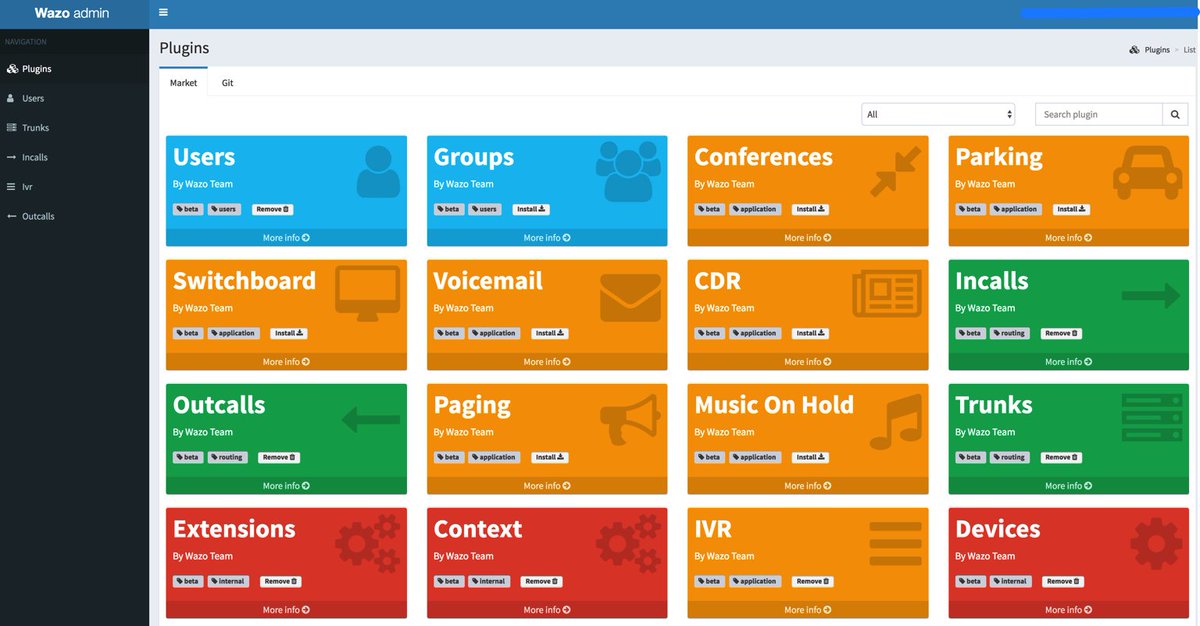
We’ve sung the praises of VirtualBox for many years because it provides a wonderful platform for experimentation as well as production-ready systems using almost any hardware and any operating system. Versions of VirtualBox are available for Windows PCs, Macs, Linux desktops, and even Solaris machines. And, once you have VirtualBox in place, you can load gigabyte-sized turnkey virtual machines in a couple minutes. It literally transforms complex computer setups into child’s play.
We’ve received dozens of emails about Wazo, and many of them go something like this:
I’d love to experiment with Wazo as an Asterisk® platform, but I worry that the environment is just too different and the learning curve too steep. I just wish there were a simple way to get started so that I could learn the basics.
Today, your prayers have been answered. You don’t have to buy any hardware. You can use the desktop computer you already have. We’ve taken the Incredible PBX for Wazo tutorial and turned it into a turnkey virtual machine for VirtualBox. You can load it in a couple minutes and be ready to go. It’s got all of the Incredible PBX bells and whistles, and extensions already are configured for a SIP phone and WebRTC so that you can hit the ground running. Just install VirtualBox. Next, load the Incredible PBX for Wazo image. Install your favorite SIP phone or run WebRTC in your browser. A complete WebRTC tutorial is available here. Once you finish configuring your SIP or WebRTC client, you’re ready to start making calls. You can add a SIP trunk using one of preconfigured setups by following one of SIP provider tutorials we’ve provided. Or, if you live in the United States, you can add a Google Voice trunk and make free calls in the U.S. and Canada. Let’s get started!
Installing Oracle VM VirtualBox

Oracle’s virtual machine platform inherited from Sun is amazing. It’s not only free, but it’s pure GPL2 code. VirtualBox gives you a virtual machine platform that runs on top of any desktop operating system. In terms of limitations, we haven’t found any. We even tested this on an Atom-based Windows 7 machine with 2GB of RAM, and it worked without a hiccup. So step #1 today is to download one or more of the VirtualBox installers from VirtualBox.org or Oracle.com. Our recommendation is to put all of the 100MB installers on a 4GB thumb drive.1 Then you’ll have everything in one place whenever and wherever you happen to need it. Once you’ve downloaded the software, simply install it onto your favorite desktop machine. Accept all of the default settings, and you’ll be good to go. For more details, here’s a link to the Oracle VM VirtualBox User Manual.
Installing Incredible PBX for Wazo VM
To begin, download Incredible PBX for Wazo .ova image (1.9 GB) to the computer on which you installed VirtualBox.
When the download completes, double-click on the .ova file you downloaded to load it into VirtualBox. When prompted, be sure to check the Reinitialize the Mac address of all network cards box, agree to the license agreement, and then click the Import button. Once the import is finished, you’ll see a new (1) Incredible PBX for Wazo virtual machine in the VM List of the VirtualBox Manager Window. We need to make a couple of one-time adjustments to the Incredible PBX for Wazo configuration to account for differences in sound and network cards on different host machines.
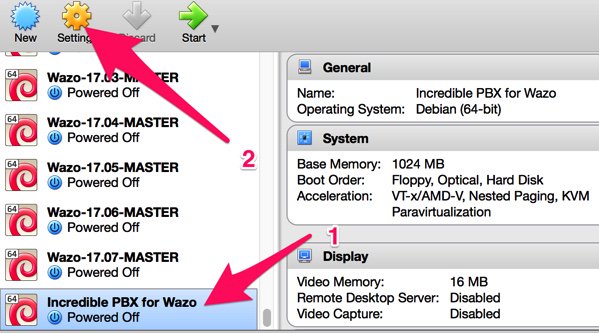
(1) Click once on the Incredible PBX for Wazo virtual machine in the VM List. Then (2) click the Settings button. In the Audio tab, check the Enable Audio option and choose your sound card. In the Network tab for Adapter 1, check the Enable Network Adapter option. From the Attached to pull-down menu, choose Bridged Adapter. Then select your network card from the Name list. Then click OK. That’s all the configuration that is necessary for your Incredible PBX for Wazo.
Running Incredible PBX for Wazo VM
Once you’ve imported and configured the Incredible PBX for Wazo Virtual Machine, you’re ready to go. Highlight Incredible PBX for Wazo virtual machine in the VM List on the VirtualBox Manager Window and click the Start button. The standard Wazo boot procedure will begin and, within a short time, you’ll get the familiar Linux login prompt. During the bootstrap procedure, you’ll see a couple of dialogue boxes pop up that explain the keystrokes to move back and forth between your host operating system desktop and your virtual machine. Remember, you still have full access to your desktop computer. Incredible PBX for Wazo is merely running as a task in a VirtualBox window. Always gracefully halt Incredible PBX just as you would on a dedicated computer.
Here’s what you need to know. To work in the Incredible PBX for Wazo virtual machine, just left-click your mouse while it is positioned inside the VM window. To return to your host operating system desktop, press the right Option key on Windows machines or the left Command key on any Mac. For other operating systems, read the dialogue boxes for instructions on moving around. To access the Linux CLI, login as root with the default password: password.
Once you log into your virtual machine, a startup script will briefly configure a few things and then advise you that it’s time to reboot. If prompted for the hostname, type xivo. Write down the IP address provided because for Phase 2 of the setup, we need to use SSH or Putty on the desktop that you will actually be using to manage your server. The reason for this is that Incredible PBX automatically creates a whitelist of IP addresses that the firewall will allow to access your server. If the IP address isn’t in your whitelist, you may lock yourself out except from the VirtualBox console window.
Once the VirtualBox console window shows that your server has rebooted by displaying the Linux login prompt, switch to SSH or Putty and login as root using the IP address you wrote down. You’ll then be prompted to change your root password for Linux as well as your root password for Wazo GUI access using a web browser. You’ll also need to set a PIN that will be used to authorize access to extension 123 to schedule Telephone Reminders on your server. This completes the configuration. You’ll get a final screen showing the credentials for the preconfigured 701 and 702 extensions as well as a reminder that your PortKnocker credentials are stored in /root/knock.FAQ in the event you ever lock yourself out of your machine. It’s a good idea to leave this screen displayed while you install and configure a softphone since you can cut-and-paste your extension 702 credentials without having to type anything. Extension 701 comes preconfigured to support WebRTC using a Chrome or Firefox browser.
Once you complete the SIP or WebRTC setup below, you can return to the SSH window and press ENTER to finish the install. The Incredible PBX Automatic Update Utility will run, and then you will be presented with the pbxstatus display. You can access the Asterisk CLI by typing: asterisk -rvvvvvvvvvv. Exit from the CLI by typing quit. As mentioned previously, always shut down your server gracefully by typing halt. When prompted for the hostname, type xivo. Once the shutdown procedure finishes, it’s safe to turn off your virtual machine.
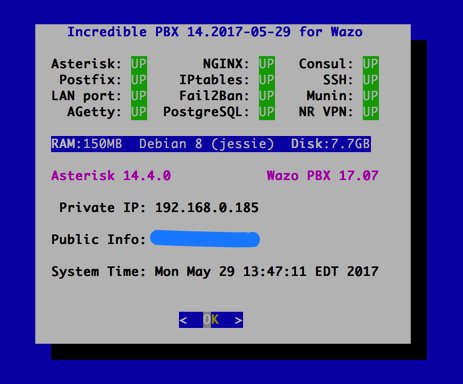
Choosing a SIP Softphone for Incredible PBX
Softphones tend to be a matter of taste for most folks so we’ll keep our suggestions to a minimum. On the Windows platform, it’s hard to go wrong with X-Lite. It works out of the box by simply plugging in the IP address of your server and your SIP username and password. It also happens to be free. The only downside is that X-Lite has a nasty habit of embedding time bombs in their free software so you may have to reinstall it from time to time. If you know what you’re doing, Zoiper is another alternative but be advised that it doesn’t work out of the box on servers behind NAT-based routers.
On the Mac platform, our favorite free softphone is Telephone. It’s a barebones SIP client that just works. As with X-Lite, you plug in your server’s IP address and SIP credentials, and you’re in business.
On the Linux or Solaris platforms, we assume that you know what you’re doing and that you are perfectly capable of choosing and installing a SIP phone that meets your requirements.
Incredible PBX Application Quick Start Guide
We’ve finished the basic Incredible PBX for Wazo setup. You now have a functioning PBX with dozens of applications for Asterisk that work out of the box. It’s probably a good idea to spend a little time getting acquainted with Incredible PBX for Wazo before you add trunks to communicate with the outside world.
Here’s a handy cheat sheet for some of the Incredible PBX applications that have been installed or are available as add-ons. There’s also a link for more information.
- Google Voice CLI interface and SMS Message Blasting (Add-On)
- CallerID Superfecta – Match Names to CallerID Numbers
- CallerID Blacklist – Block Calls from Spammers and Old Girlfriends
- CDR Reports in CSV Format
- CDR Reports in SQLite3 Format
- Asteridex – The Poor Man’s Rolodex (SQLite3 version)
- AsteriDex Click-to-Dial with Wazo Phonebook
- NeoRouter VPN for Wazo
- FCC RoboCall BlackList
- CallerID WhiteList Override
- Dial 123 – Telephone Reminders
- Dial 411 – Call by Name from AsteriDex
- Dial 947 – Weather Forecasts by ZIP Code
- Dial 951 – Latest Yahoo News
- Dial 2663 – Conference Call
- Dial 3472 – DISA Access
- Dial 4871 – Allison’s Sample IVR
- Dial *881400 – Schedule an Alarm for 2 p.m. (1400 military time)
- Dial 53669 – Meet Lenny, the Robocaller’s Worst Nightmare
Configuring Trunks and Routes with Wazo
The next step in your Wazo adventure is connecting your PBX to the outside world so that you can make and receive phone calls from anywhere in the world. For this you’ll need one or more trunks. Unlike the Ma Bell world, there’s no reason to put all your eggs in one basket. You can use one or more trunk providers for incoming calls with separate phone numbers for each. And you can use one or more trunk providers for outgoing calls and save money on calls to certain countries by choosing the best provider for where you want to call. And, of course, if you live in the United States, you can set up one or more Google Voice trunks and make calls to the U.S. and Canada for free. We’ve written a number of tutorials to make it easy to set up these trunks.
To get started, point a web browser to the IP address of your PBX. Login as root with the Wazo GUI password you set up above. If you ever forget your password, you can run /root/admin-pw-change to reconfigure it.
Wazo Trunk Implementation Tutorials
- Wazo Trunks Tutorial: Installing a Vitelity SIP Trunk2
- Wazo Trunks Tutorial: Installing a VoIP.ms SIP Trunk
- Wazo Trunks Tutorial: Installing a FreeVoipDeal (Betamax) SIP Trunk
- Wazo Trunks Tutorial: Installing a Google Voice-Simonics SIP Trunk
- Wazo Trunks Tutorial: Deploying Native Google Voice with OAuth Trunks
- Wazo Trunks Tutorial: Installing an Anveo Direct Outbound SIP Trunk
- Wazo Trunks Tutorial: Installing a Skype Connect SIP Trunk
Once you’ve added one or more trunks, you’ll need to tell Wazo how to route outgoing and incoming calls. Here are our step-by-step tutorials on setting up Outbound Calling Routes and Incoming Call Routes:
Wazo Call Routing Tutorials
- Wazo Call Routing Tutorial: Creating Outbound Routes for PSTN Calling
- Wazo Call Routing Tutorial: Creating Inbound Routes for DIDs
Now you’re ready to explore. We recommend you read through the Incredible PBX for Wazo tutorial to familiarize yourself with the inner workings of Wazo. Enjoy the ride!
Originally published: Monday, June 12, 2017

Need help with Asterisk? Visit the PBX in a Flash Forum.
Special Thanks to Our Generous Sponsors
FULL DISCLOSURE: ClearlyIP, Skyetel, Vitelity, DigitalOcean, Vultr, VoIP.ms, 3CX, Sangoma, TelecomsXchange and VitalPBX have provided financial support to Nerd Vittles and our open source projects through advertising, referral revenue, and/or merchandise. As an Amazon Associate and Best Buy Affiliate, we also earn from qualifying purchases. We’ve chosen these providers not the other way around. Our decisions are based upon their corporate reputation and the quality of their offerings and pricing. Our recommendations regarding technology are reached without regard to financial compensation except in situations in which comparable products at comparable pricing are available from multiple sources. In this limited case, we support our sponsors because our sponsors support us.
 BOGO Bonaza: Enjoy state-of-the-art VoIP service with a $10 credit and half-price SIP service on up to $500 of Skyetel trunking with free number porting when you fund your Skyetel account. No limits on number of simultaneous calls. Quadruple data center redundancy. $25 monthly minimum spend required. Tutorial and sign up details are here.
BOGO Bonaza: Enjoy state-of-the-art VoIP service with a $10 credit and half-price SIP service on up to $500 of Skyetel trunking with free number porting when you fund your Skyetel account. No limits on number of simultaneous calls. Quadruple data center redundancy. $25 monthly minimum spend required. Tutorial and sign up details are here.
 The lynchpin of Incredible PBX 2020 and beyond is ClearlyIP components which bring management of FreePBX modules and SIP phone integration to a level never before available with any other Asterisk distribution. And now you can configure and reconfigure your new Incredible PBX phones from the convenience of the Incredible PBX GUI.
The lynchpin of Incredible PBX 2020 and beyond is ClearlyIP components which bring management of FreePBX modules and SIP phone integration to a level never before available with any other Asterisk distribution. And now you can configure and reconfigure your new Incredible PBX phones from the convenience of the Incredible PBX GUI.
 VitalPBX is perhaps the fastest-growing PBX offering based upon Asterisk with an installed presence in more than 100 countries worldwide. VitalPBX has generously provided a customized White Label version of Incredible PBX tailored for use with all Incredible PBX and VitalPBX custom applications. Follow this link for a free test drive!
VitalPBX is perhaps the fastest-growing PBX offering based upon Asterisk with an installed presence in more than 100 countries worldwide. VitalPBX has generously provided a customized White Label version of Incredible PBX tailored for use with all Incredible PBX and VitalPBX custom applications. Follow this link for a free test drive!
 Special Thanks to Vitelity. Vitelity is now Voyant Communications and has halted new registrations for the time being. Our special thanks to Vitelity for their unwavering financial support over many years and to the many Nerd Vittles readers who continue to enjoy the benefits of their service offerings. We will keep everyone posted on further developments.
Special Thanks to Vitelity. Vitelity is now Voyant Communications and has halted new registrations for the time being. Our special thanks to Vitelity for their unwavering financial support over many years and to the many Nerd Vittles readers who continue to enjoy the benefits of their service offerings. We will keep everyone posted on further developments.
Some Recent Nerd Vittles Articles of Interest…
- Many of our purchase links refer users to Amazon when we find their prices are competitive for the recommended products. Nerd Vittles receives a small referral fee from Amazon to help cover the costs of our blog. We never recommend particular products solely to generate Amazon commissions. However, when pricing is comparable or availability is favorable, we support Amazon because Amazon supports us. [↩]
- Vitelity is a platinum sponsor of Nerd Vittles, and they also happen to be the best in the business. You’ll find a discount coupon to get a great deal on a DID and 4-channel trunk toward the end of this article. [↩]
Postfix + Gmail: A Pain-Free SMTP Relay for Wazo PBX

Let’s face it. As the number of Internet service providers blocking downstream email servers continues to proliferate, getting a reliable email server configured with Incredible PBX™ and other VoIP servers has become painful. If you’re new to all of this, here’s the simple explanation. Internet providers such as Comcast intentionally block outbound email from mail servers managed by their residential customers. While it may appear arbitrary, there actually is a good reason. The bad guys quickly discovered that many folks setting up SendMail and Postfix servers didn’t much know what they were doing, and it became fairly easy to turn these servers into anonymous email relay hosts for spammers. The sledgehammer solution was to simply block all of these servers from sending outbound email except through Comcast’s SMTP servers. In the VoIP world, that meant you could no longer depend upon your server to notify you when critical services came unglued.
We previously have posted tutorials showing how to configure SendMail to send outbound emails using either your Gmail account or your Comcast account. There’s one major problem on the Wazo platform. It uses Postfix instead of SendMail. More importantly, you can’t replace the mail server without breaking Wazo.
Configuring Gmail as an SMTP Relay Host for Postfix
So here’s the step-by-step procedure to configure Wazo to use Gmail as your SMTP relay:
1. Log into your server as root and issue the following command:
dpkg-reconfigure postfix
Click OK on the first dialog. Choose Internet Site as your Type of Mail Configuration. Accept the defaults for the System Mail Name, Root and Postmaster Recipient, and Other Destinations. Choose Yes for Forced Synchronous updates. Accept the defaults for the Local Networks, Default Mailbox Size, and Local Address Extension Character. Choose IPv4 for the Internet Protocol.
2. Once Postfix is reconfigured, edit /etc/postfix/main.cf. In the second section of code beginning with relayhost =, replace it with the following block of commands:
relayhost = [smtp.gmail.com]:587 smtp_use_tls = yes smtp_sasl_auth_enable = yes smtp_sasl_security_options = noanonymous smtp_sasl_password_maps = hash:/etc/postfix/sasl_passwd smtp_tls_CAfile = /etc/ssl/certs/ca-certificates.crt smtp_fallback_relay =
3. Install the following package: apt-get install libsasl2-modules
4. Create the following new file using your Gmail account name and password.
nano -w /etc/postfix/sasl_passwd:
[smtp.gmail.com]:587 yourname@gmail.com:yourpassword
5. Change the permissions on the sasl_passwd file:
chmod 600 /etc/postfix/sasl_passwd
6. Use postmap to compile and hash the sasl_passwd file:
postmap /etc/postfix/sasl_passwd
7. Restart Postfix: /etc/init.d/postfix restart
8. Send yourself a test email: echo "test" | mail -s "Test Mail" somebody@gmail.com
What Could Possibly Go Wrong?
In a perfect world, you’d be all set, and your emails would start arriving as scheduled. But things aren’t always that simple.
If you happen to be using a Gmail account with 2-Step Verification enabled, then your standard Gmail password obviously isn’t going to work. Instead, you’ll need to create an App Password for exclusive use with Postfix. Here’s how. Once you’ve generated the password, just substitute it for your standard Gmail password in step #4 above. Then recompile and hash the sasl_passwd file in step #6 and restart Postfix in step #7.
If your Gmail account was created from an IP address that differs from the IP address of your Wazo server, then you may also need to relax Google’s security mechanisms before attempting to send your first email in step #8. Login to your Gmail account and perform the Google Reset Procedure. Then enable Less Secure Apps using this Google tool. Now attempt to send yourself a test email as documented in step #8 above. Enjoy!
Published: Monday, May 29, 2017
 Support Issues. With any application as sophisticated as this one, you’re bound to have questions. Blog comments are a difficult place to address support issues although we welcome general comments about our articles and software. If you have particular support issues, we encourage you to get actively involved in the PBX in a Flash Forum. It’s the best Asterisk tech support site in the business, and it’s all free! Please have a look and post your support questions there. Unlike some forums, the PIAF Forum is extremely friendly and is supported by literally hundreds of Asterisk gurus and thousands of users just like you. You won’t have to wait long for an answer to your question.
Support Issues. With any application as sophisticated as this one, you’re bound to have questions. Blog comments are a difficult place to address support issues although we welcome general comments about our articles and software. If you have particular support issues, we encourage you to get actively involved in the PBX in a Flash Forum. It’s the best Asterisk tech support site in the business, and it’s all free! Please have a look and post your support questions there. Unlike some forums, the PIAF Forum is extremely friendly and is supported by literally hundreds of Asterisk gurus and thousands of users just like you. You won’t have to wait long for an answer to your question.

Need help with Asterisk? Visit the PBX in a Flash Forum.
Special Thanks to Our Generous Sponsors
FULL DISCLOSURE: ClearlyIP, Skyetel, Vitelity, DigitalOcean, Vultr, VoIP.ms, 3CX, Sangoma, TelecomsXchange and VitalPBX have provided financial support to Nerd Vittles and our open source projects through advertising, referral revenue, and/or merchandise. As an Amazon Associate and Best Buy Affiliate, we also earn from qualifying purchases. We’ve chosen these providers not the other way around. Our decisions are based upon their corporate reputation and the quality of their offerings and pricing. Our recommendations regarding technology are reached without regard to financial compensation except in situations in which comparable products at comparable pricing are available from multiple sources. In this limited case, we support our sponsors because our sponsors support us.
 BOGO Bonaza: Enjoy state-of-the-art VoIP service with a $10 credit and half-price SIP service on up to $500 of Skyetel trunking with free number porting when you fund your Skyetel account. No limits on number of simultaneous calls. Quadruple data center redundancy. $25 monthly minimum spend required. Tutorial and sign up details are here.
BOGO Bonaza: Enjoy state-of-the-art VoIP service with a $10 credit and half-price SIP service on up to $500 of Skyetel trunking with free number porting when you fund your Skyetel account. No limits on number of simultaneous calls. Quadruple data center redundancy. $25 monthly minimum spend required. Tutorial and sign up details are here.
 The lynchpin of Incredible PBX 2020 and beyond is ClearlyIP components which bring management of FreePBX modules and SIP phone integration to a level never before available with any other Asterisk distribution. And now you can configure and reconfigure your new Incredible PBX phones from the convenience of the Incredible PBX GUI.
The lynchpin of Incredible PBX 2020 and beyond is ClearlyIP components which bring management of FreePBX modules and SIP phone integration to a level never before available with any other Asterisk distribution. And now you can configure and reconfigure your new Incredible PBX phones from the convenience of the Incredible PBX GUI.
 VitalPBX is perhaps the fastest-growing PBX offering based upon Asterisk with an installed presence in more than 100 countries worldwide. VitalPBX has generously provided a customized White Label version of Incredible PBX tailored for use with all Incredible PBX and VitalPBX custom applications. Follow this link for a free test drive!
VitalPBX is perhaps the fastest-growing PBX offering based upon Asterisk with an installed presence in more than 100 countries worldwide. VitalPBX has generously provided a customized White Label version of Incredible PBX tailored for use with all Incredible PBX and VitalPBX custom applications. Follow this link for a free test drive!
 Special Thanks to Vitelity. Vitelity is now Voyant Communications and has halted new registrations for the time being. Our special thanks to Vitelity for their unwavering financial support over many years and to the many Nerd Vittles readers who continue to enjoy the benefits of their service offerings. We will keep everyone posted on further developments.
Special Thanks to Vitelity. Vitelity is now Voyant Communications and has halted new registrations for the time being. Our special thanks to Vitelity for their unwavering financial support over many years and to the many Nerd Vittles readers who continue to enjoy the benefits of their service offerings. We will keep everyone posted on further developments.
Some Recent Nerd Vittles Articles of Interest…
Introducing IVRs in a Flash with Incredible PBX for Wazo

Last week we introduced the all-new, API-driven Admin User Interface for Wazo 17.07. But pretty pictures are only the icing on the cake. It’s what’s under the hood that really matters. And today we want to walk you through the new IVR User Interface with Incredible PBX for Wazo. The Wazo developers heard from many of you that were missing the GUI-driven IVR tools available in other products. And we’re pleased to tell you it’s another Home Run for Wazo. The UI is well-documented, easy to use, and incredibly simple to implement.
We should mention that our focus today is on the mechanics of using the new Wazo IVR Builder. We won’t be covering how to design a good IVR. If you want some great examples of poor IVR design, look no further than the main number of your favorite cellular or cable provider. Insofar as good design tips go, you can’t do better than learning from the master, Allison Smith. Here’s a link to her previous articles on Nerd Vittles.
We’re assuming you followed last week’s tutorial and added the basic components for the Admin user interface after using your browser to login to https://IPaddress/admin/. If not, start there and install the following plugins to begin: Users, Extensions, Contexts, and Devices. Next, add the plugins for Incalls, Outcalls, Trunks, and IVR. The whole setup procedure takes less than a minute. When you’re finished, your Navigation Sidebar should look like what’s shown above.
You’re obviously going to need a SIP or Google Voice trunk to handle incoming IVR calls so start there if you haven’t already set up at least one trunk that can be dedicated to your IVR. For the time being, add an Inbound Route for the Trunk that points to an extension.

Now we’re ready to create your first IVR using the new IVR template in the Admin UI. Using your web browser, log back in to https://IPaddress/admin/ and (1) click IVR in the Navigation bar. Then (2) click + Add to create a new IVR.
Since the pieces already are in place for the hard-coded Demo IVR that comes with Incredible PBX for Wazo, let’s use those components to demonstrate how easy it is to build your own IVR with the new GUI. As you can see from the completed form below, there are two main sections in setting up an IVR. There are some basic settings that handle answering the call, playing the welcome message, and managing error conditions. Then there are IVR options that correspond to the Digit pressed by the caller using a touchtone phone. Each of these options has a destination. Currently, the available options include playing a sound file, ringing an extension, running custom dialplan code, or hanging up a call. There also is the ability to nest IVRs. Once you have built the secondary IVRs, the options list will also include an IVR option.
Since our sample IVR uses custom contexts for each of the Incredible PBX applications, we’ll rely heavily on the Custom option to route calls to extensions that were created when these applications were installed: Call by Name (411), Join Conference (2663), Lenny (53669), Yahoo News (951), and Weather Forecasts by ZIP Code (947). We’ll also show you how to direct a call to an extension using the default WebRTC extension (701). To get things going, simply copy the entries shown below and then Save/Update the template. The Wazo syntax to call a Custom destination looks like this: Dial(Local/951@default).
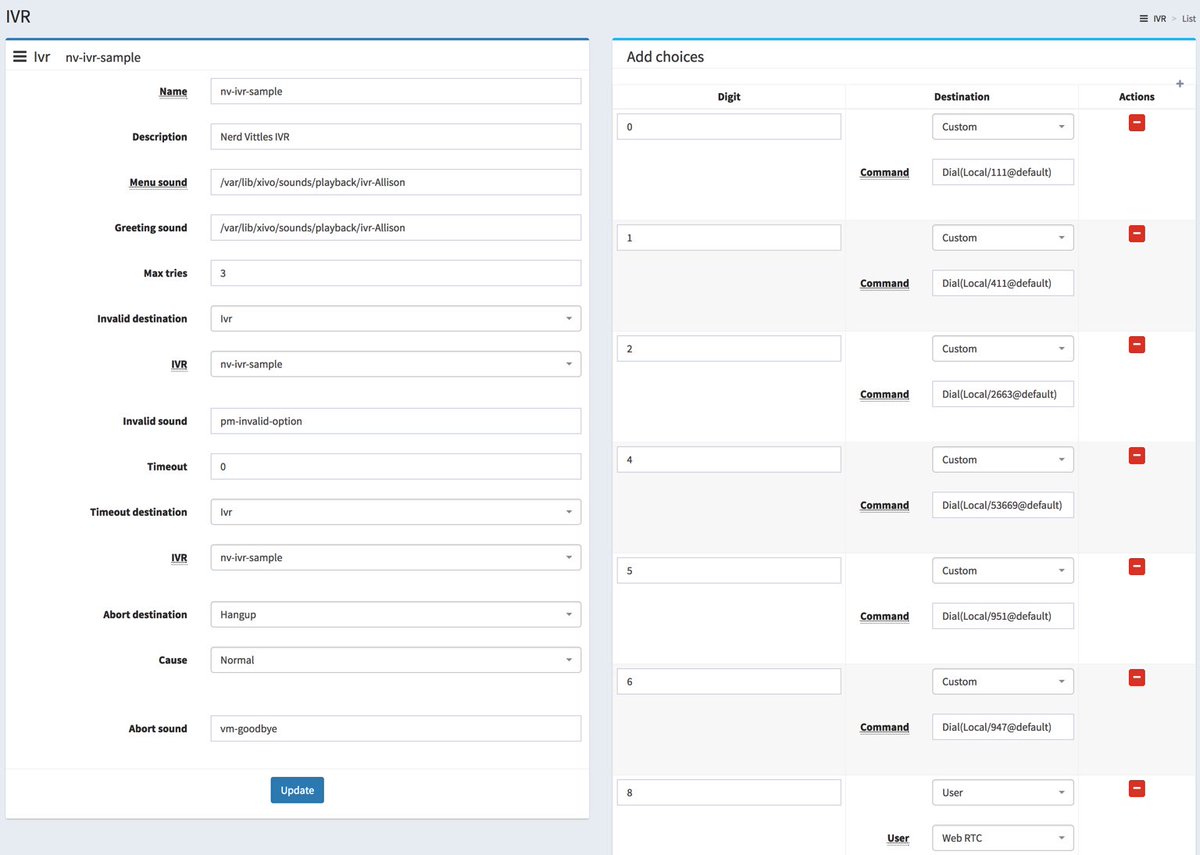
Before you attempt to build your own IVR, keep in mind that you’ll need at least a greeting message that tells callers which buttons to press. This file should be placed in /var/lib/xivo/sounds/playback. You can also use any of the default sound recordings found in /usr/share/asterisk/sounds/en for error messages and retry alerts.
Once you have your IVR built, the last step is to adjust an incoming route for one of your DIDs so that it points to your newly created IVR. We do this using the Incalls option in the Navigation bar. If you’re adjusting an existing inbound route, just call it up and make the changes as shown below:
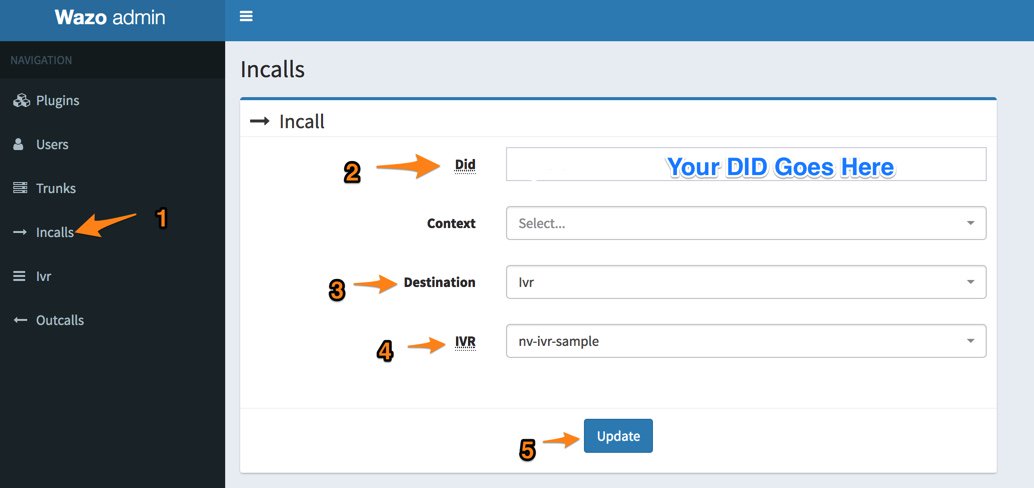
You’re good to go now. Call your DID from another phone and try out your first custom IVR.
Enjoy!
Published: Monday, May 22, 2017
 Support Issues. With any application as sophisticated as this one, you’re bound to have questions. Blog comments are a difficult place to address support issues although we welcome general comments about our articles and software. If you have particular support issues, we encourage you to get actively involved in the PBX in a Flash Forum. It’s the best Asterisk tech support site in the business, and it’s all free! Please have a look and post your support questions there. Unlike some forums, the PIAF Forum is extremely friendly and is supported by literally hundreds of Asterisk gurus and thousands of users just like you. You won’t have to wait long for an answer to your question.
Support Issues. With any application as sophisticated as this one, you’re bound to have questions. Blog comments are a difficult place to address support issues although we welcome general comments about our articles and software. If you have particular support issues, we encourage you to get actively involved in the PBX in a Flash Forum. It’s the best Asterisk tech support site in the business, and it’s all free! Please have a look and post your support questions there. Unlike some forums, the PIAF Forum is extremely friendly and is supported by literally hundreds of Asterisk gurus and thousands of users just like you. You won’t have to wait long for an answer to your question.

Need help with Asterisk? Visit the PBX in a Flash Forum.
Special Thanks to Our Generous Sponsors
FULL DISCLOSURE: ClearlyIP, Skyetel, Vitelity, DigitalOcean, Vultr, VoIP.ms, 3CX, Sangoma, TelecomsXchange and VitalPBX have provided financial support to Nerd Vittles and our open source projects through advertising, referral revenue, and/or merchandise. As an Amazon Associate and Best Buy Affiliate, we also earn from qualifying purchases. We’ve chosen these providers not the other way around. Our decisions are based upon their corporate reputation and the quality of their offerings and pricing. Our recommendations regarding technology are reached without regard to financial compensation except in situations in which comparable products at comparable pricing are available from multiple sources. In this limited case, we support our sponsors because our sponsors support us.
 BOGO Bonaza: Enjoy state-of-the-art VoIP service with a $10 credit and half-price SIP service on up to $500 of Skyetel trunking with free number porting when you fund your Skyetel account. No limits on number of simultaneous calls. Quadruple data center redundancy. $25 monthly minimum spend required. Tutorial and sign up details are here.
BOGO Bonaza: Enjoy state-of-the-art VoIP service with a $10 credit and half-price SIP service on up to $500 of Skyetel trunking with free number porting when you fund your Skyetel account. No limits on number of simultaneous calls. Quadruple data center redundancy. $25 monthly minimum spend required. Tutorial and sign up details are here.
 The lynchpin of Incredible PBX 2020 and beyond is ClearlyIP components which bring management of FreePBX modules and SIP phone integration to a level never before available with any other Asterisk distribution. And now you can configure and reconfigure your new Incredible PBX phones from the convenience of the Incredible PBX GUI.
The lynchpin of Incredible PBX 2020 and beyond is ClearlyIP components which bring management of FreePBX modules and SIP phone integration to a level never before available with any other Asterisk distribution. And now you can configure and reconfigure your new Incredible PBX phones from the convenience of the Incredible PBX GUI.
 VitalPBX is perhaps the fastest-growing PBX offering based upon Asterisk with an installed presence in more than 100 countries worldwide. VitalPBX has generously provided a customized White Label version of Incredible PBX tailored for use with all Incredible PBX and VitalPBX custom applications. Follow this link for a free test drive!
VitalPBX is perhaps the fastest-growing PBX offering based upon Asterisk with an installed presence in more than 100 countries worldwide. VitalPBX has generously provided a customized White Label version of Incredible PBX tailored for use with all Incredible PBX and VitalPBX custom applications. Follow this link for a free test drive!
 Special Thanks to Vitelity. Vitelity is now Voyant Communications and has halted new registrations for the time being. Our special thanks to Vitelity for their unwavering financial support over many years and to the many Nerd Vittles readers who continue to enjoy the benefits of their service offerings. We will keep everyone posted on further developments.
Special Thanks to Vitelity. Vitelity is now Voyant Communications and has halted new registrations for the time being. Our special thanks to Vitelity for their unwavering financial support over many years and to the many Nerd Vittles readers who continue to enjoy the benefits of their service offerings. We will keep everyone posted on further developments.
Some Recent Nerd Vittles Articles of Interest…
Cloud 9: VoIP on Steroids with Wazo and Vultr for $2.50/mo.

It tells you just how far we’ve come in Cloud Computing when $2.50 per month now buys you an Incredible PBX™ platform with great performance for a SOHO or home deployment. So what’s the catch? What else do you have to buy? If you’re in the United States, nothing! With a free Google Voice trunk, all of your incoming and outgoing calls to the United States and Canada are totally free. Does it matter where your phones are situated? Not at all. And how about scaling for large organizations? Not to worry! When you decide to move your entire organization to the Cloud, our friends at RentPBX stand ready to provide a 24×7 platform specifically engineered for VoIP at only $15 a month. Coupon code: NOGOTCHAS.
Getting Started with Vultr
We’ve used Vultr as our primary development platform for Nerd Vittles not only because of its price but also because of its reliability and feature set. With the recent reduction in the price of cloud instances, it’s now more than compelling as a stand-alone cloud solution for VoIP applications. An additional 50¢ a month buys you automatic daily, weekly, or monthly backups to a separate, fault tolerant storage system in the same data center. And, of course, Wazo itself generates nightly backups as well. What’s not to like? But don’t take our word for it. Walk through this tutorial with Vultr. You can even pay by the hour and kick the tires. Five hours of experimentation will set you back a whopping 2¢. Nope, that’s not a typo!
As you might imagine, the $2.50/month cloud instances at Vultr have been well received. In fact, that’s an understatement. Rather than oversubscribe users on their cloud platforms, Vultr limits the number of $2.50 cloud instances on each server. Lucky for all of us, Vultr maintains cloud hosting services in 15 cities around the world. As this is written, the $2.50 instances still were available in New York and Miami. Those locations obviously can change by the hour, but we have yet to see them disappear completely. A word to the wise: HURRY!
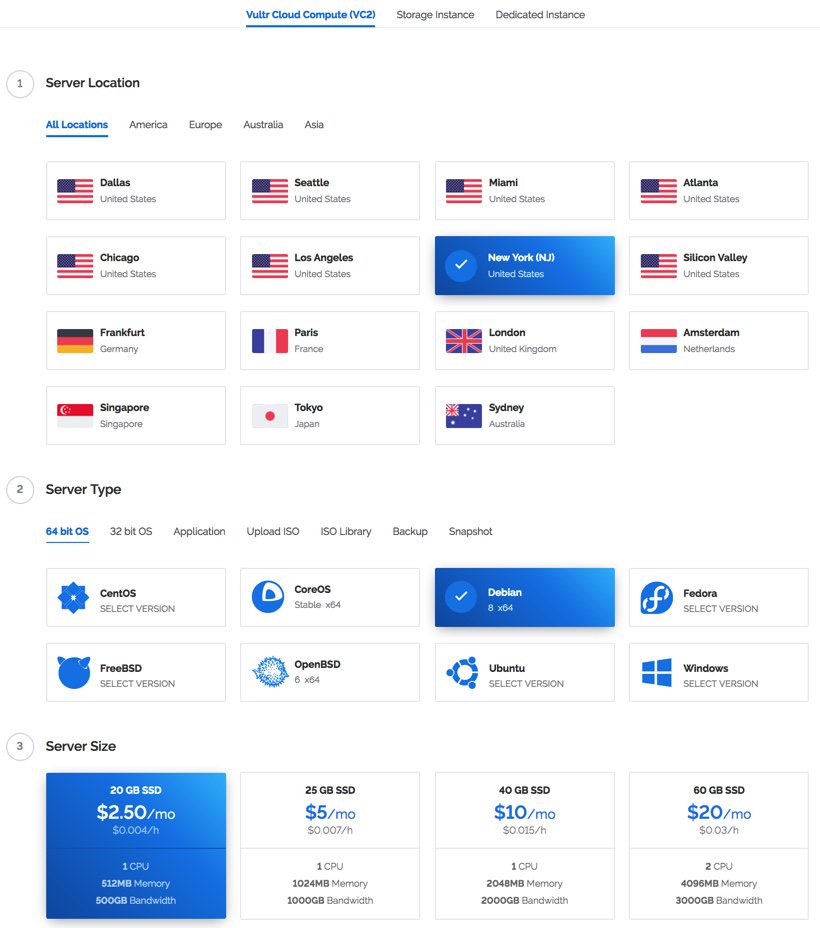
Getting Started with Incredible PBX for Wazo
After you have set up your account at Vultr using our referral link,1 the first step is to create your new cloud instance. Choose the desired site that has $2.50/month availability and select the 64-bit Debian 8 as your server platform. IMPORTANT: With Wazo, it’s extremely important that you leave the Server Hostname & Label blank. Otherwise, Wazo’s setup wizard will fail.
(1) Once you’ve built and started your new virtual machine, log into your server as root using SSH/Putty and immediately change your root password: passwd.
(2) With the $2.50 size VULTR virtual machine, you must create a swapfile before beginning the Incredible PBX for Wazo installation. Here are the commands:
dd if=/dev/zero of=/swapfile bs=1024 count=1024k chown root:root /swapfile chmod 0600 /swapfile mkswap /swapfile swapon /swapfile echo "/swapfile swap swap defaults 0 0">>/etc/fstab sysctl vm.swappiness=10 echo vm.swappiness=10>>/etc/sysctl.conf free -h cat /proc/sys/vm/swappiness
(3) Now you’re ready to kick off the Incredible PBX for Wazo install. The first phase is to bring Debian 8 up to current specs. Here are the commands:
cd /root apt-get -y install cloud-init wget http://incrediblepbx.com/IncrediblePBX14-Wazo.sh chmod +x IncrediblePBX14-Wazo.sh ./IncrediblePBX14-Wazo.sh
(4) Once the Debian 8 upgrade is complete, reboot your server and log back in as root. Then run the Incredible PBX for Wazo installer a second time:
./IncrediblePBX14-Wazo.sh
(5) Your server will pause after the Wazo install is complete. Verify that Wazo started successfully by pressing the ENTER key.
(6) Your server then will run the Wazo setup wizard. Verify that the wizard completed without errors by pressing the ENTER key.
(7) The Incredible PBX for Wazo installer then will complete the remainder of the setup without user intervention. It takes less than 10 minutes.
(8) Now proceed to the Incredible PBX Initial Configuration tutorial to continue your setup and begin your adventure. Enjoy!
Published: Monday, May 15, 2017
 Support Issues. With any application as sophisticated as this one, you’re bound to have questions. Blog comments are a difficult place to address support issues although we welcome general comments about our articles and software. If you have particular support issues, we encourage you to get actively involved in the PBX in a Flash Forum. It’s the best Asterisk tech support site in the business, and it’s all free! Please have a look and post your support questions there. Unlike some forums, the PIAF Forum is extremely friendly and is supported by literally hundreds of Asterisk gurus and thousands of users just like you. You won’t have to wait long for an answer to your question.
Support Issues. With any application as sophisticated as this one, you’re bound to have questions. Blog comments are a difficult place to address support issues although we welcome general comments about our articles and software. If you have particular support issues, we encourage you to get actively involved in the PBX in a Flash Forum. It’s the best Asterisk tech support site in the business, and it’s all free! Please have a look and post your support questions there. Unlike some forums, the PIAF Forum is extremely friendly and is supported by literally hundreds of Asterisk gurus and thousands of users just like you. You won’t have to wait long for an answer to your question.

Need help with Asterisk? Visit the PBX in a Flash Forum.
Special Thanks to Our Generous Sponsors
FULL DISCLOSURE: ClearlyIP, Skyetel, Vitelity, DigitalOcean, Vultr, VoIP.ms, 3CX, Sangoma, TelecomsXchange and VitalPBX have provided financial support to Nerd Vittles and our open source projects through advertising, referral revenue, and/or merchandise. As an Amazon Associate and Best Buy Affiliate, we also earn from qualifying purchases. We’ve chosen these providers not the other way around. Our decisions are based upon their corporate reputation and the quality of their offerings and pricing. Our recommendations regarding technology are reached without regard to financial compensation except in situations in which comparable products at comparable pricing are available from multiple sources. In this limited case, we support our sponsors because our sponsors support us.
 BOGO Bonaza: Enjoy state-of-the-art VoIP service with a $10 credit and half-price SIP service on up to $500 of Skyetel trunking with free number porting when you fund your Skyetel account. No limits on number of simultaneous calls. Quadruple data center redundancy. $25 monthly minimum spend required. Tutorial and sign up details are here.
BOGO Bonaza: Enjoy state-of-the-art VoIP service with a $10 credit and half-price SIP service on up to $500 of Skyetel trunking with free number porting when you fund your Skyetel account. No limits on number of simultaneous calls. Quadruple data center redundancy. $25 monthly minimum spend required. Tutorial and sign up details are here.
 The lynchpin of Incredible PBX 2020 and beyond is ClearlyIP components which bring management of FreePBX modules and SIP phone integration to a level never before available with any other Asterisk distribution. And now you can configure and reconfigure your new Incredible PBX phones from the convenience of the Incredible PBX GUI.
The lynchpin of Incredible PBX 2020 and beyond is ClearlyIP components which bring management of FreePBX modules and SIP phone integration to a level never before available with any other Asterisk distribution. And now you can configure and reconfigure your new Incredible PBX phones from the convenience of the Incredible PBX GUI.
 VitalPBX is perhaps the fastest-growing PBX offering based upon Asterisk with an installed presence in more than 100 countries worldwide. VitalPBX has generously provided a customized White Label version of Incredible PBX tailored for use with all Incredible PBX and VitalPBX custom applications. Follow this link for a free test drive!
VitalPBX is perhaps the fastest-growing PBX offering based upon Asterisk with an installed presence in more than 100 countries worldwide. VitalPBX has generously provided a customized White Label version of Incredible PBX tailored for use with all Incredible PBX and VitalPBX custom applications. Follow this link for a free test drive!
 Special Thanks to Vitelity. Vitelity is now Voyant Communications and has halted new registrations for the time being. Our special thanks to Vitelity for their unwavering financial support over many years and to the many Nerd Vittles readers who continue to enjoy the benefits of their service offerings. We will keep everyone posted on further developments.
Special Thanks to Vitelity. Vitelity is now Voyant Communications and has halted new registrations for the time being. Our special thanks to Vitelity for their unwavering financial support over many years and to the many Nerd Vittles readers who continue to enjoy the benefits of their service offerings. We will keep everyone posted on further developments.
Some Recent Nerd Vittles Articles of Interest…
- Vultr provides a modest referral credit to Nerd Vittles for those that use our referral code. It in no way colors our recommendation of Vultr. As we noted, we use Vultr as our primary development platform, and we did so long before there were referral credits. You won’t be disappointed. [↩]


 JUST RELEASED: Visit the Incredible PBX Wiki
JUST RELEASED: Visit the Incredible PBX Wiki